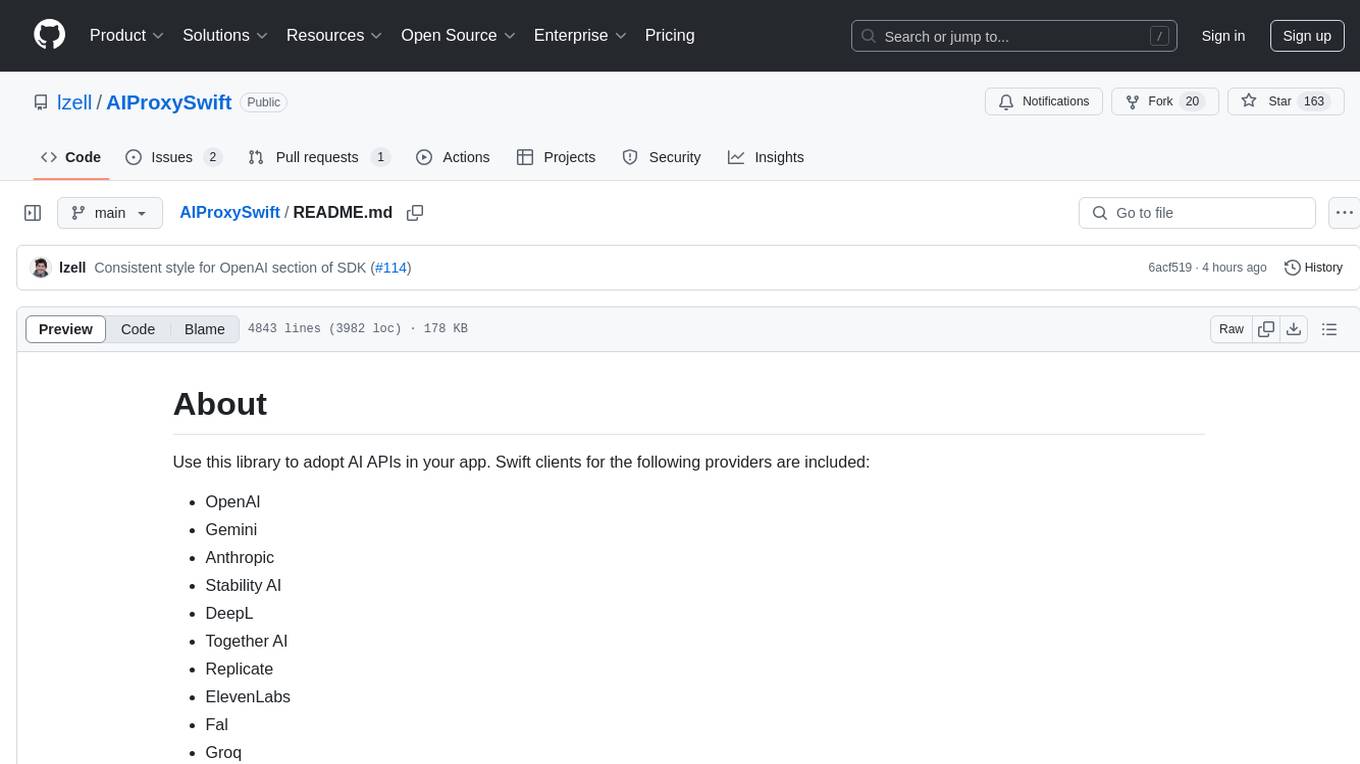
aiohttp-pydantic
Aiohttp View that validates request body and query sting regarding the annotations declared in the View method
Stars: 63
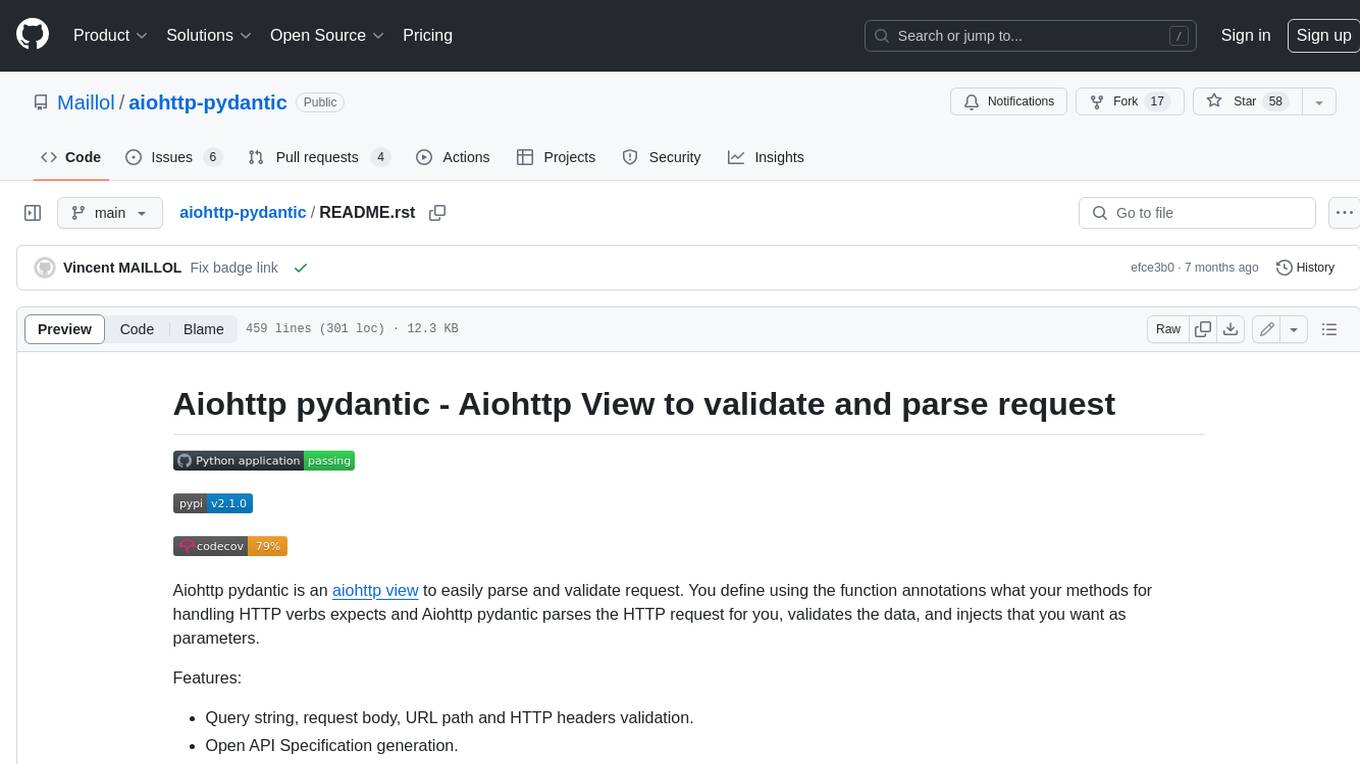
Aiohttp pydantic is an aiohttp view to easily parse and validate requests. You define using function annotations what your methods for handling HTTP verbs expect, and Aiohttp pydantic parses the HTTP request for you, validates the data, and injects the parameters you want. It provides features like query string, request body, URL path, and HTTP headers validation, as well as Open API Specification generation.
README:
.. image:: https://github.com/Maillol/aiohttp-pydantic/actions/workflows/install-package-and-test.yml/badge.svg :target: https://github.com/Maillol/aiohttp-pydantic/actions/workflows/install-package-and-test.yml :alt: CI Status
.. image:: https://img.shields.io/pypi/v/aiohttp-pydantic :target: https://img.shields.io/pypi/v/aiohttp-pydantic :alt: Latest PyPI package version
.. image:: https://codecov.io/gh/Maillol/aiohttp-pydantic/branch/main/graph/badge.svg :target: https://codecov.io/gh/Maillol/aiohttp-pydantic :alt: codecov.io status for master branch
Aiohttp pydantic is an aiohttp view_ to easily parse and validate request.
You define using the function annotations what your methods for handling HTTP verbs expects and Aiohttp pydantic parses the HTTP request
for you, validates the data, and injects that you want as parameters.
Features:
- Query string, request body, URL path and HTTP headers validation.
- Open API Specification generation.
.. code-block:: bash
$ pip install aiohttp_pydantic
.. code-block:: python3
from typing import Optional
from aiohttp import web
from aiohttp_pydantic import PydanticView
from pydantic import BaseModel
# Use pydantic BaseModel to validate request body
class ArticleModel(BaseModel):
name: str
nb_page: Optional[int]
# Create your PydanticView and add annotations.
class ArticleView(PydanticView):
async def post(self, article: ArticleModel):
return web.json_response({'name': article.name,
'number_of_page': article.nb_page})
async def get(self, with_comments: bool=False):
return web.json_response({'with_comments': with_comments})
app = web.Application()
app.router.add_view('/article', ArticleView)
web.run_app(app)
.. code-block:: bash
$ curl -X GET http://127.0.0.1:8080/article?with_comments=a
[
{
"in": "query string",
"loc": [
"with_comments"
],
"msg": "Input should be a valid boolean, unable to interpret input",
"input": "a",
"type": "bool_parsing"
}
]
$ curl -X GET http://127.0.0.1:8080/article?with_comments=yes
{"with_comments": true}
$ curl -H "Content-Type: application/json" -X POST http://127.0.0.1:8080/article --data '{}'
[
{
"in": "body",
"loc": [
"name"
],
"msg": "Field required",
"input": {},
"type": "missing"
},
{
"in": "body",
"loc": [
"nb_page"
],
"msg": "Field required",
"input": {},
"type": "missing"
}
]
$ curl -H "Content-Type: application/json" -X POST http://127.0.0.1:8080/article --data '{"name": "toto", "nb_page": "3"}'
{"name": "toto", "number_of_page": 3}
.. code-block:: python3
from typing import Optional
from aiohttp import web
from aiohttp_pydantic.decorator import inject_params
from pydantic import BaseModel
# Use pydantic BaseModel to validate request body
class ArticleModel(BaseModel):
name: str
nb_page: Optional[int]
# Create your function decorated by 'inject_params' and add annotations.
@inject_params
async def post(article: ArticleModel):
return web.json_response({'name': article.name,
'number_of_page': article.nb_page})
# If you need request
@inject_params.and_request
async def get(request, with_comments: bool = False):
request.app["logger"]("OK")
return web.json_response({'with_comments': with_comments})
app = web.Application()
app["logger"] = print
app.router.add_post('/article', post)
app.router.add_get('/article', get)
web.run_app(app)
Inject Path Parameters
To declare a path parameter, you must declare your argument as a `positional-only parameters`_:
Example:
.. code-block:: python3
class AccountView(PydanticView):
async def get(self, customer_id: str, account_id: str, /):
...
app = web.Application()
app.router.add_get('/customers/{customer_id}/accounts/{account_id}', AccountView)
Inject Query String Parameters
To declare a query parameter, you must declare your argument as a simple argument:
.. code-block:: python3
class AccountView(PydanticView):
async def get(self, customer_id: Optional[str] = None):
...
app = web.Application()
app.router.add_get('/customers', AccountView)
A query string parameter is generally optional and we do not want to force the user to set it in the URL. It's recommended to define a default value. It's possible to get a multiple value for the same parameter using the List type
.. code-block:: python3
from typing import List
from pydantic import Field
class AccountView(PydanticView):
async def get(self, tags: List[str] = Field(default_factory=list)):
...
app = web.Application()
app.router.add_get('/customers', AccountView)
Inject Request Body
To declare a body parameter, you must declare your argument as a simple argument annotated with `pydantic Model`_.
.. code-block:: python3
class Customer(BaseModel):
first_name: str
last_name: str
class CustomerView(PydanticView):
async def post(self, customer: Customer):
...
app = web.Application()
app.router.add_view('/customers', CustomerView)
Inject HTTP headers
To declare a HTTP headers parameter, you must declare your argument as a keyword-only argument_.
.. code-block:: python3
class CustomerView(PydanticView):
async def get(self, *, authorization: str, expire_at: datetime):
...
app = web.Application()
app.router.add_view('/customers', CustomerView)
.. _positional-only parameters: https://www.python.org/dev/peps/pep-0570/ .. _pydantic Model: https://pydantic-docs.helpmanual.io/usage/models/ .. _keyword-only argument: https://www.python.org/dev/peps/pep-3102/
aiohttp_pydantic provides a sub-application to serve a route to generate Open Api Specification reading annotation in your PydanticView. Use aiohttp_pydantic.oas.setup() to add the sub-application
.. code-block:: python3
from aiohttp import web
from aiohttp_pydantic import oas
app = web.Application()
oas.setup(app)
By default, the route to display the Open Api Specification is /oas but you can change it using url_prefix parameter
.. code-block:: python3
oas.setup(app, url_prefix='/spec-api')
If you want generate the Open Api Specification from specific aiohttp sub-applications. on the same route, you must use apps_to_expose parameter.
.. code-block:: python3
from aiohttp import web
from aiohttp_pydantic import oas
app = web.Application()
sub_app_1 = web.Application()
sub_app_2 = web.Application()
oas.setup(app, apps_to_expose=[sub_app_1, sub_app_2])
You can change the title or the version of the generated open api specification using title_spec and version_spec parameters:
.. code-block:: python3
oas.setup(app, title_spec="My application", version_spec="1.2.3")
Add annotation to define response content
The module aiohttp_pydantic.oas.typing provides class to annotate a
response content.
For example *r200[List[Pet]]* means the server responses with
the status code 200 and the response content is a List of Pet where Pet will be
defined using a pydantic.BaseModel
The docstring of methods will be parsed to fill the descriptions in the
Open Api Specification.
.. code-block:: python3
from aiohttp_pydantic import PydanticView
from aiohttp_pydantic.oas.typing import r200, r201, r204, r404
class Pet(BaseModel):
id: int
name: str
class Error(BaseModel):
error: str
class PetCollectionView(PydanticView):
async def get(self) -> r200[List[Pet]]:
"""
Find all pets
Tags: pet
"""
pets = self.request.app["model"].list_pets()
return web.json_response([pet.dict() for pet in pets])
async def post(self, pet: Pet) -> r201[Pet]:
"""
Add a new pet to the store
Tags: pet
Status Codes:
201: The pet is created
"""
self.request.app["model"].add_pet(pet)
return web.json_response(pet.dict())
class PetItemView(PydanticView):
async def get(self, id: int, /) -> Union[r200[Pet], r404[Error]]:
"""
Find a pet by ID
Tags: pet
Status Codes:
200: Successful operation
404: Pet not found
"""
pet = self.request.app["model"].find_pet(id)
return web.json_response(pet.dict())
async def put(self, id: int, /, pet: Pet) -> r200[Pet]:
"""
Update an existing pet
Tags: pet
Status Codes:
200: successful operation
"""
self.request.app["model"].update_pet(id, pet)
return web.json_response(pet.dict())
async def delete(self, id: int, /) -> r204:
self.request.app["model"].remove_pet(id)
return web.Response(status=204)
Group parameters
----------------
If your method has lot of parameters you can group them together inside one or several Groups.
.. code-block:: python3
from aiohttp_pydantic.injectors import Group
class Pagination(Group):
page_num: int = 1
page_size: int = 15
class ArticleView(PydanticView):
async def get(self, page: Pagination):
articles = Article.get(page.page_num, page.page_size)
...
The parameters page_num and page_size are expected in the query string, and
set inside a Pagination object passed as page parameter.
The code above is equivalent to:
.. code-block:: python3
class ArticleView(PydanticView):
async def get(self, page_num: int = 1, page_size: int = 15):
articles = Article.get(page_num, page_size)
...
You can add methods or properties to your Group.
.. code-block:: python3
class Pagination(Group):
page_num: int = 1
page_size: int = 15
@property
def num(self):
return self.page_num
@property
def size(self):
return self.page_size
def slice(self):
return slice(self.num, self.size)
class ArticleView(PydanticView):
async def get(self, page: Pagination):
articles = Article.get(page.num, page.size)
...
Custom Validation error
-----------------------
You can redefine the on_validation_error hook in your PydanticView
.. code-block:: python3
class PetView(PydanticView):
async def on_validation_error(self,
exception: ValidationError,
context: str):
errors = exception.errors()
for error in errors:
error["in"] = context # context is "body", "headers", "path" or "query string"
error["custom"] = "your custom field ..."
return json_response(data=errors, status=400)
If you use function based view:
.. code-block:: python3
async def custom_error(exception: ValidationError,
context: str):
errors = exception.errors()
for error in errors:
error["in"] = context # context is "body", "headers", "path" or "query string"
error["custom"] = "your custom field ..."
return json_response(data=errors, status=400)
@inject_params(on_validation_error=custom_error)
async def get(with_comments: bool = False):
...
@inject_params.and_request(on_validation_error=custom_error)
async def get(request, with_comments: bool = False):
...
A tip to use the same error handling on each view
.. code-block:: python3
inject_params = inject_params(on_validation_error=custom_error)
@inject_params
async def post(article: ArticleModel):
return web.json_response({'name': article.name,
'number_of_page': article.nb_page})
@inject_params.and_request
async def get(request, with_comments: bool = False):
return web.json_response({'with_comments': with_comments})
Add security to the endpoints
-----------------------------
aiohttp_pydantic provides a basic way to add security to the endpoints. You can define the security
on the setup level using the *security* parameter and then mark view methods that will require this security schema.
.. code-block:: python3
from aiohttp import web
from aiohttp_pydantic import oas
app = web.Application()
oas.setup(app, security={"APIKeyHeader": {"type": "apiKey", "in": "header", "name": "Authorization"}})
And then mark the view method with the *security* descriptor
.. code-block:: python3
from aiohttp_pydantic import PydanticView
from aiohttp_pydantic.oas.typing import r200, r201, r204, r404
class Pet(BaseModel):
id: int
name: str
class Error(BaseModel):
error: str
class PetCollectionView(PydanticView):
async def get(self) -> r200[List[Pet]]:
"""
Find all pets
Security: APIKeyHeader
Tags: pet
"""
pets = self.request.app["model"].list_pets()
return web.json_response([pet.dict() for pet in pets])
async def post(self, pet: Pet) -> r201[Pet]:
"""
Add a new pet to the store
Tags: pet
Status Codes:
201: The pet is created
"""
self.request.app["model"].add_pet(pet)
return web.json_response(pet.dict())
Demo
----
Have a look at `demo`_ for a complete example
.. code-block:: bash
git clone https://github.com/Maillol/aiohttp-pydantic.git
cd aiohttp-pydantic
pip install .
python -m demo
Go to http://127.0.0.1:8080/oas
You can generate the OAS in a json or yaml file using the aiohttp_pydantic.oas command:
.. code-block:: bash
python -m aiohttp_pydantic.oas demo.main
.. code-block:: bash
$ python3 -m aiohttp_pydantic.oas --help
usage: __main__.py [-h] [-b FILE] [-o FILE] [-f FORMAT] [APP [APP ...]]
Generate Open API Specification
positional arguments:
APP The name of the module containing the asyncio.web.Application. By default the variable named
'app' is loaded but you can define an other variable name ending the name of module with :
characters and the name of variable. Example: my_package.my_module:my_app If your
asyncio.web.Application is returned by a function, you can use the syntax:
my_package.my_module:my_app()
optional arguments:
-h, --help show this help message and exit
-b FILE, --base-oas-file FILE
A file that will be used as base to generate OAS
-o FILE, --output FILE
File to write the output
-f FORMAT, --format FORMAT
The output format, can be 'json' or 'yaml' (default is json)
.. _demo: https://github.com/Maillol/aiohttp-pydantic/tree/main/demo
.. _aiohttp view: https://docs.aiohttp.org/en/stable/web_quickstart.html#class-based-views
For Tasks:
Click tags to check more tools for each tasksFor Jobs:
Alternative AI tools for aiohttp-pydantic
Similar Open Source Tools

aiohttp-pydantic
Aiohttp pydantic is an aiohttp view to easily parse and validate requests. You define using function annotations what your methods for handling HTTP verbs expect, and Aiohttp pydantic parses the HTTP request for you, validates the data, and injects the parameters you want. It provides features like query string, request body, URL path, and HTTP headers validation, as well as Open API Specification generation.
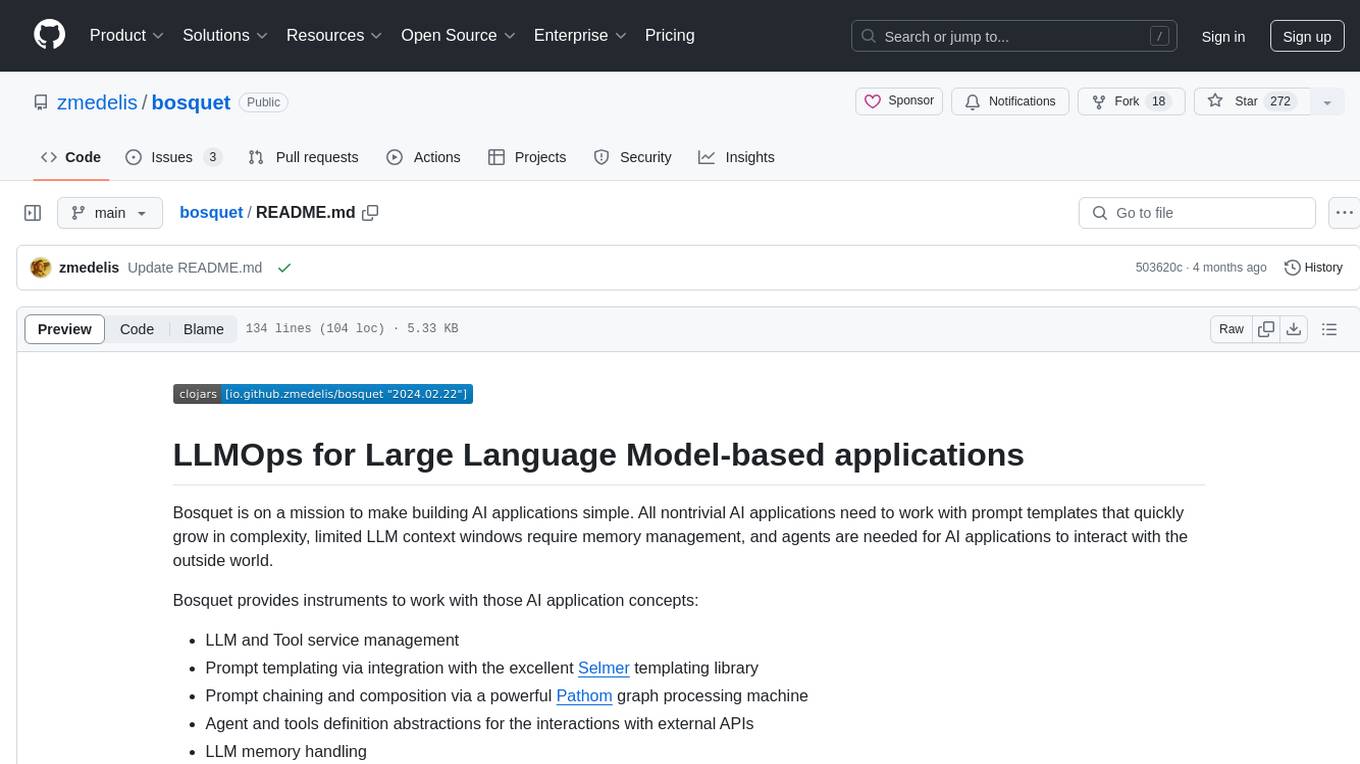
bosquet
Bosquet is a tool designed for LLMOps in large language model-based applications. It simplifies building AI applications by managing LLM and tool services, integrating with Selmer templating library for prompt templating, enabling prompt chaining and composition with Pathom graph processing, defining agents and tools for external API interactions, handling LLM memory, and providing features like call response caching. The tool aims to streamline the development process for AI applications that require complex prompt templates, memory management, and interaction with external systems.
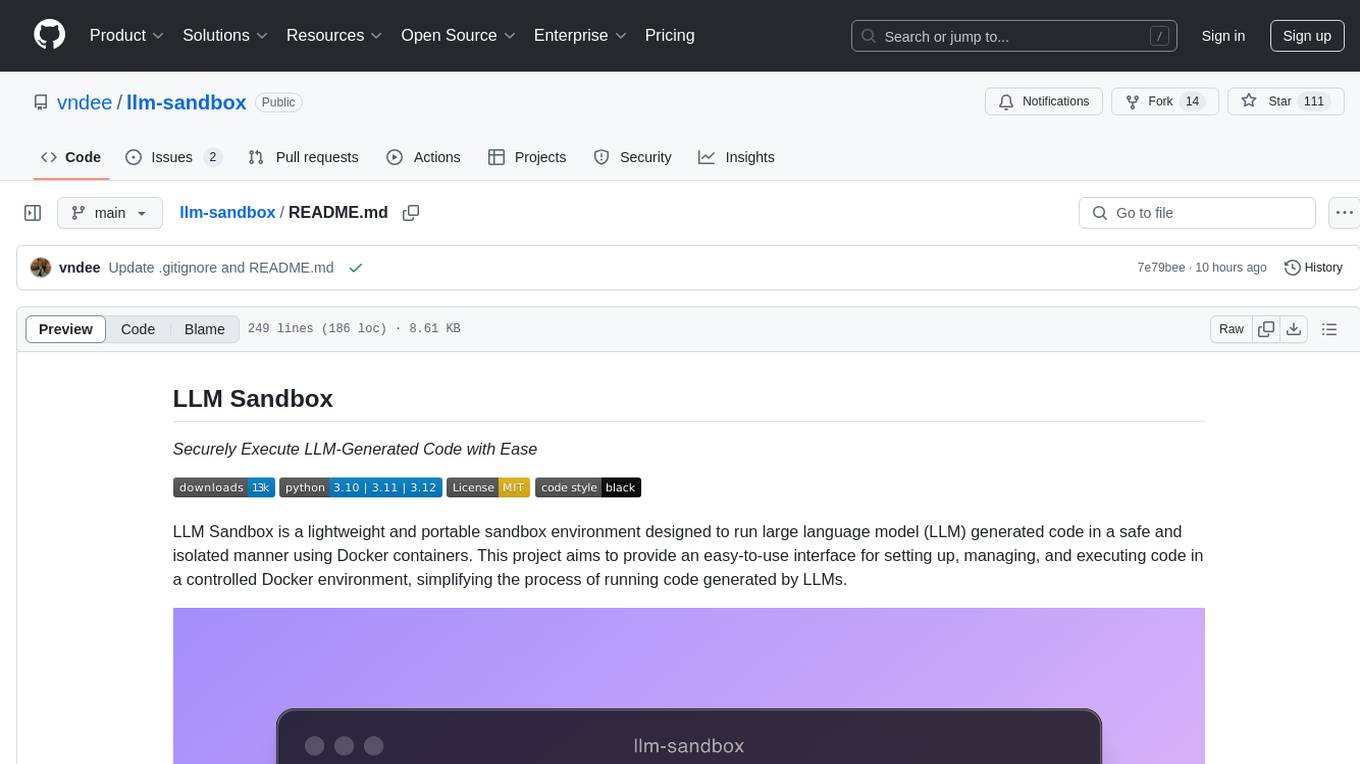
llm-sandbox
LLM Sandbox is a lightweight and portable sandbox environment designed to securely execute large language model (LLM) generated code in a safe and isolated manner using Docker containers. It provides an easy-to-use interface for setting up, managing, and executing code in a controlled Docker environment, simplifying the process of running code generated by LLMs. The tool supports multiple programming languages, offers flexibility with predefined Docker images or custom Dockerfiles, and allows scalability with support for Kubernetes and remote Docker hosts.
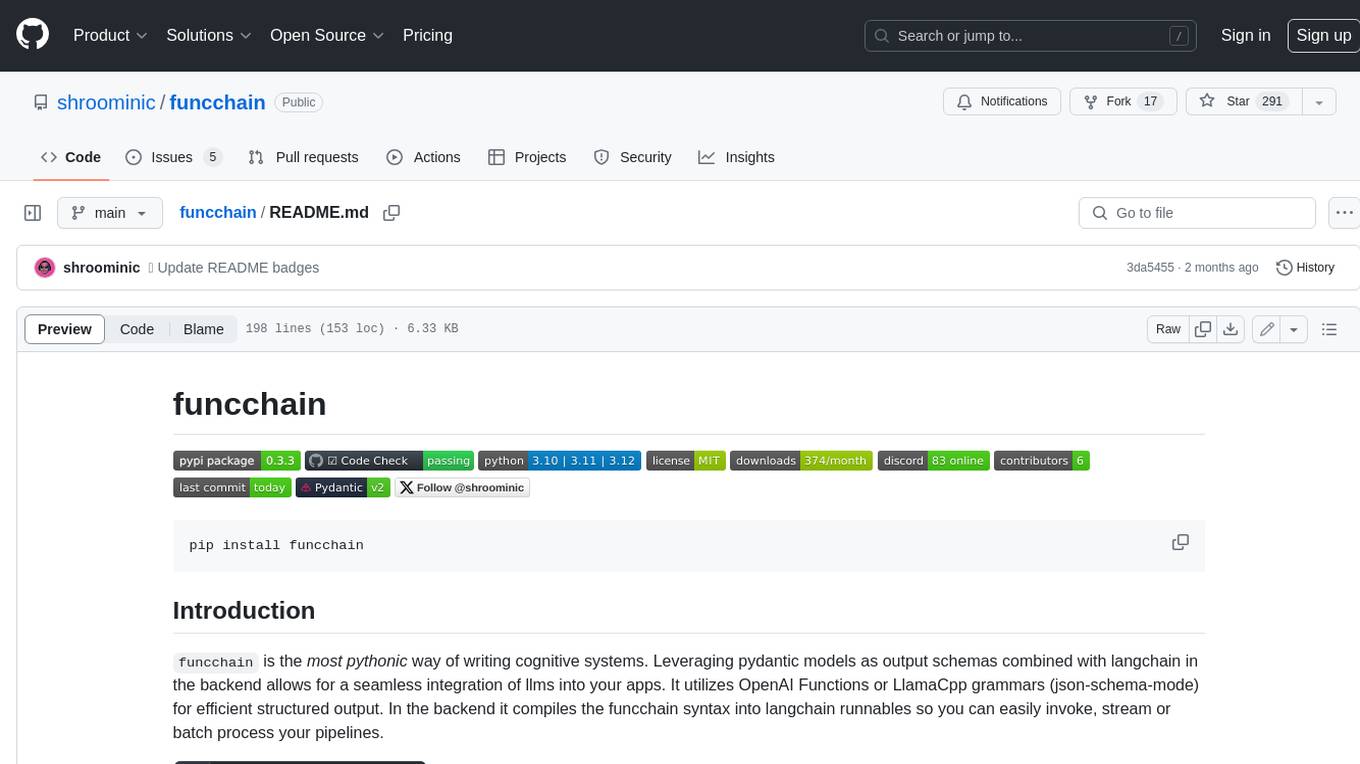
funcchain
Funcchain is a Python library that allows you to easily write cognitive systems by leveraging Pydantic models as output schemas and LangChain in the backend. It provides a seamless integration of LLMs into your apps, utilizing OpenAI Functions or LlamaCpp grammars (json-schema-mode) for efficient structured output. Funcchain compiles the Funcchain syntax into LangChain runnables, enabling you to invoke, stream, or batch process your pipelines effortlessly.
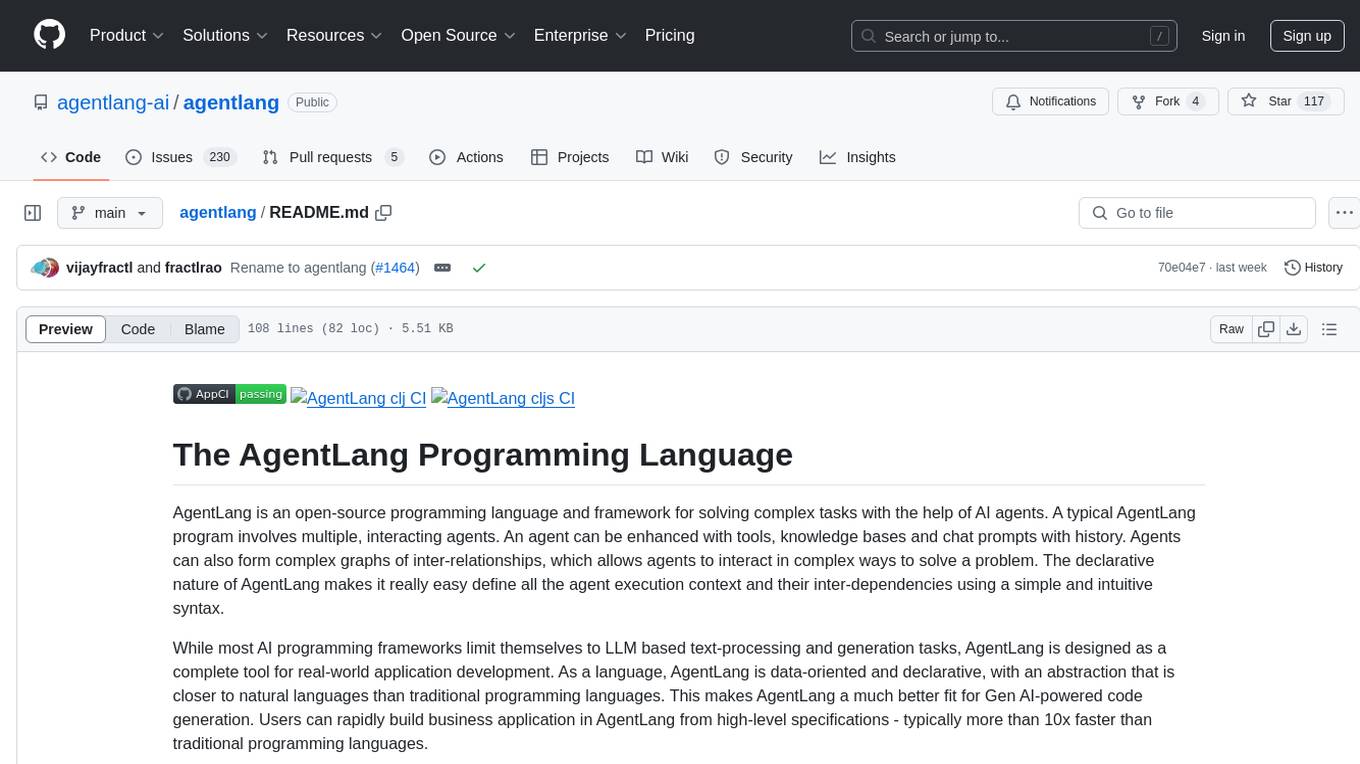
agentlang
AgentLang is an open-source programming language and framework designed for solving complex tasks with the help of AI agents. It allows users to build business applications rapidly from high-level specifications, making it more efficient than traditional programming languages. The language is data-oriented and declarative, with a syntax that is intuitive and closer to natural languages. AgentLang introduces innovative concepts such as first-class AI agents, graph-based hierarchical data model, zero-trust programming, declarative dataflow, resolvers, interceptors, and entity-graph-database mapping.
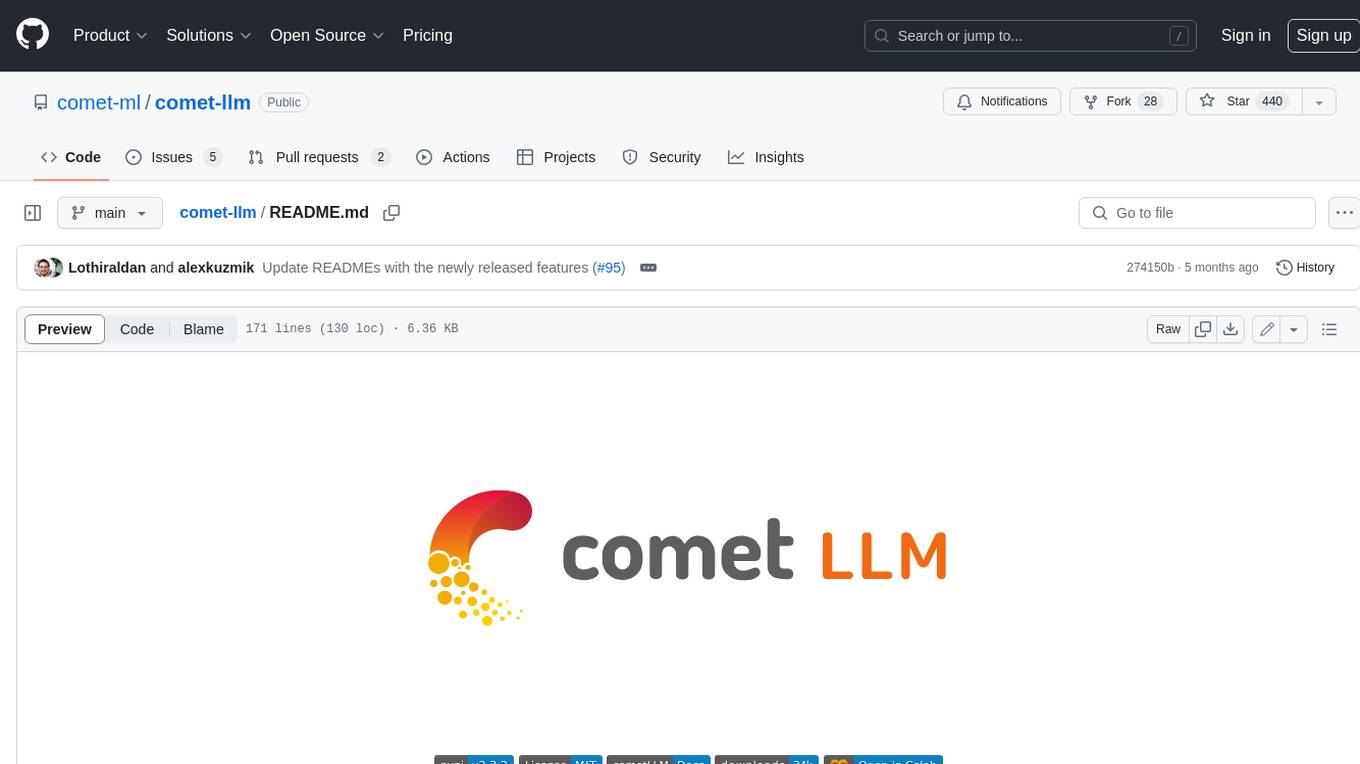
comet-llm
CometLLM is a tool to log and visualize your LLM prompts and chains. Use CometLLM to identify effective prompt strategies, streamline your troubleshooting, and ensure reproducible workflows!

agent-sdk-go
Agent Go SDK is a powerful Go framework for building production-ready AI agents that seamlessly integrates memory management, tool execution, multi-LLM support, and enterprise features into a flexible, extensible architecture. It offers core capabilities like multi-model intelligence, modular tool ecosystem, advanced memory management, and MCP integration. The SDK is enterprise-ready with built-in guardrails, complete observability, and support for enterprise multi-tenancy. It provides a structured task framework, declarative configuration, and zero-effort bootstrapping for development experience. The SDK supports environment variables for configuration and includes features like creating agents with YAML configuration, auto-generating agent configurations, using MCP servers with an agent, and CLI tool for headless usage.
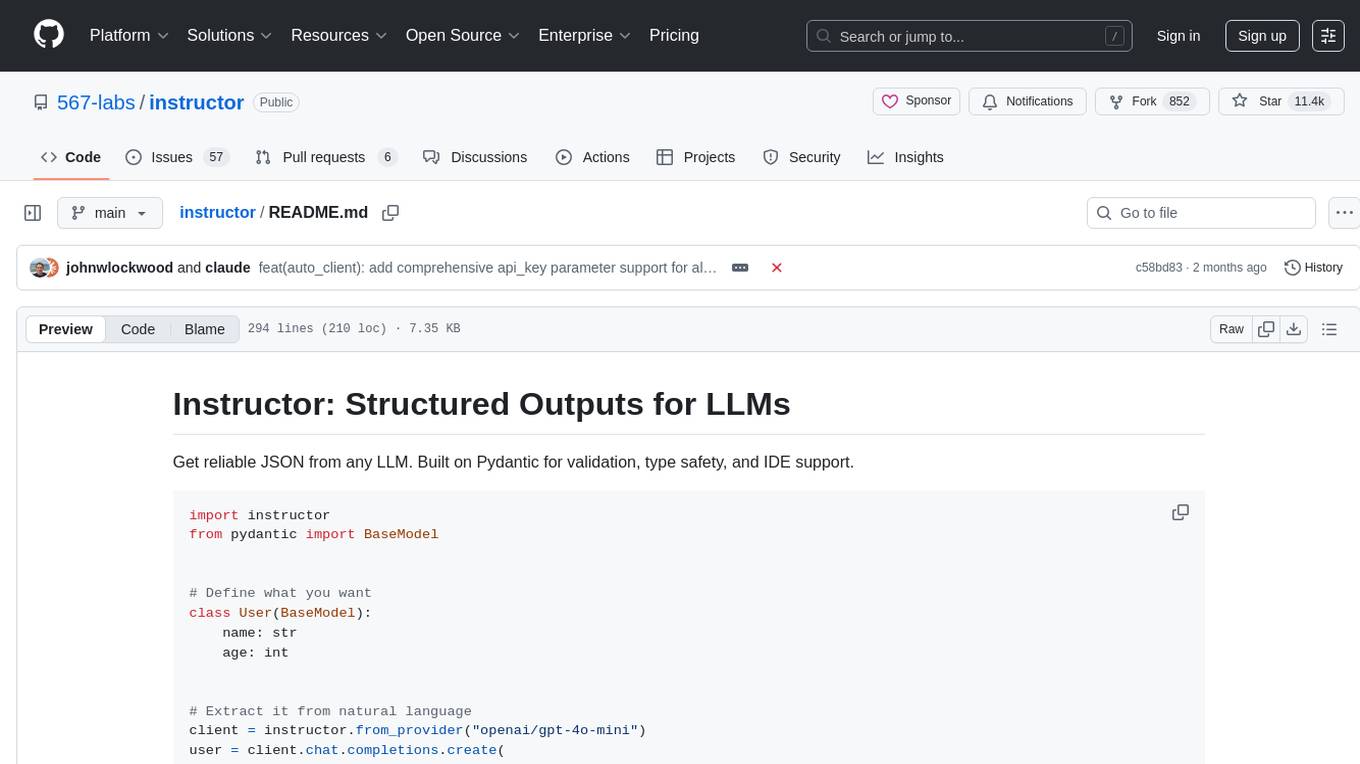
instructor
Instructor is a tool that provides structured outputs from Large Language Models (LLMs) in a reliable manner. It simplifies the process of extracting structured data by utilizing Pydantic for validation, type safety, and IDE support. With Instructor, users can define models and easily obtain structured data without the need for complex JSON parsing, error handling, or retries. The tool supports automatic retries, streaming support, and extraction of nested objects, making it production-ready for various AI applications. Trusted by a large community of developers and companies, Instructor is used by teams at OpenAI, Google, Microsoft, AWS, and YC startups.
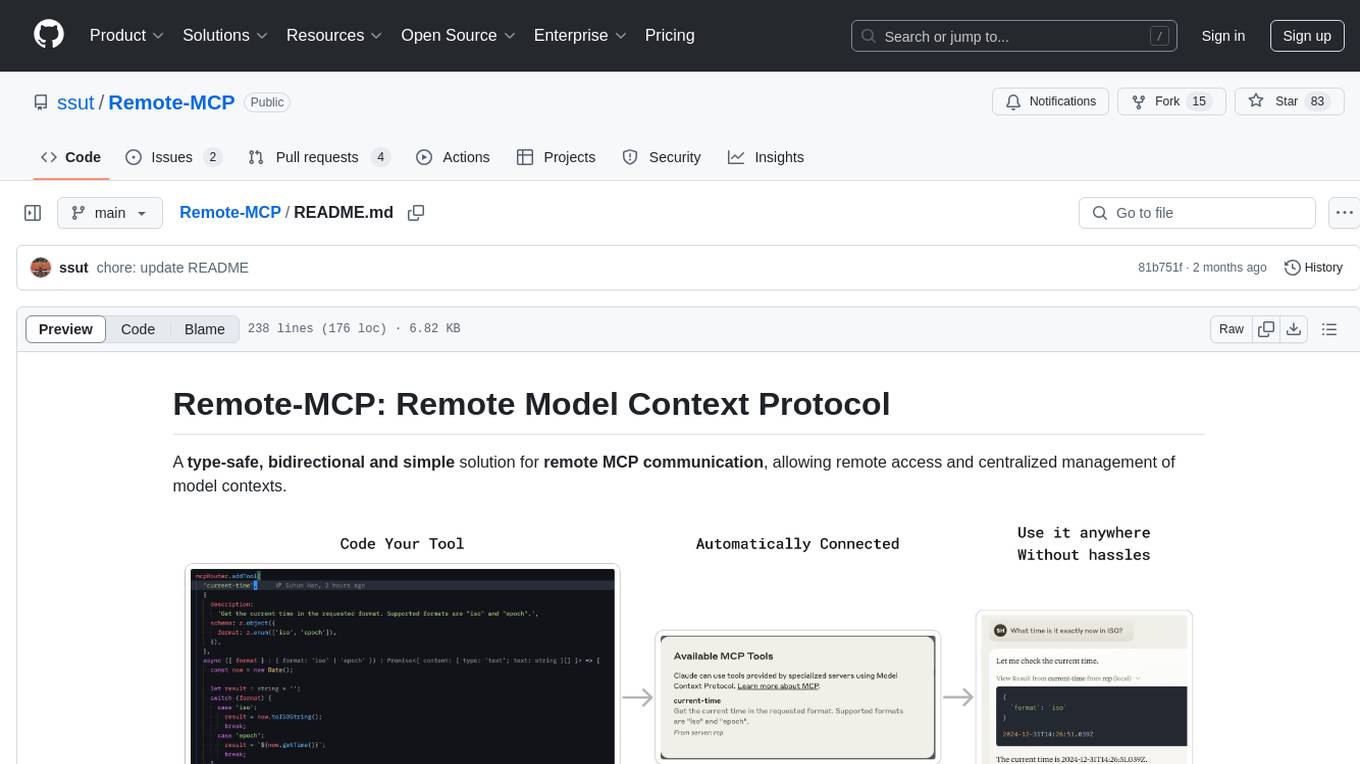
Remote-MCP
Remote-MCP is a type-safe, bidirectional, and simple solution for remote MCP communication, enabling remote access and centralized management of model contexts. It provides a bridge for immediate remote access to a remote MCP server from a local MCP client, without waiting for future official implementations. The repository contains client and server libraries for creating and connecting to remotely accessible MCP services. The core features include basic type-safe client/server communication, MCP command/tool/prompt support, custom headers, and ongoing work on crash-safe handling and event subscription system.
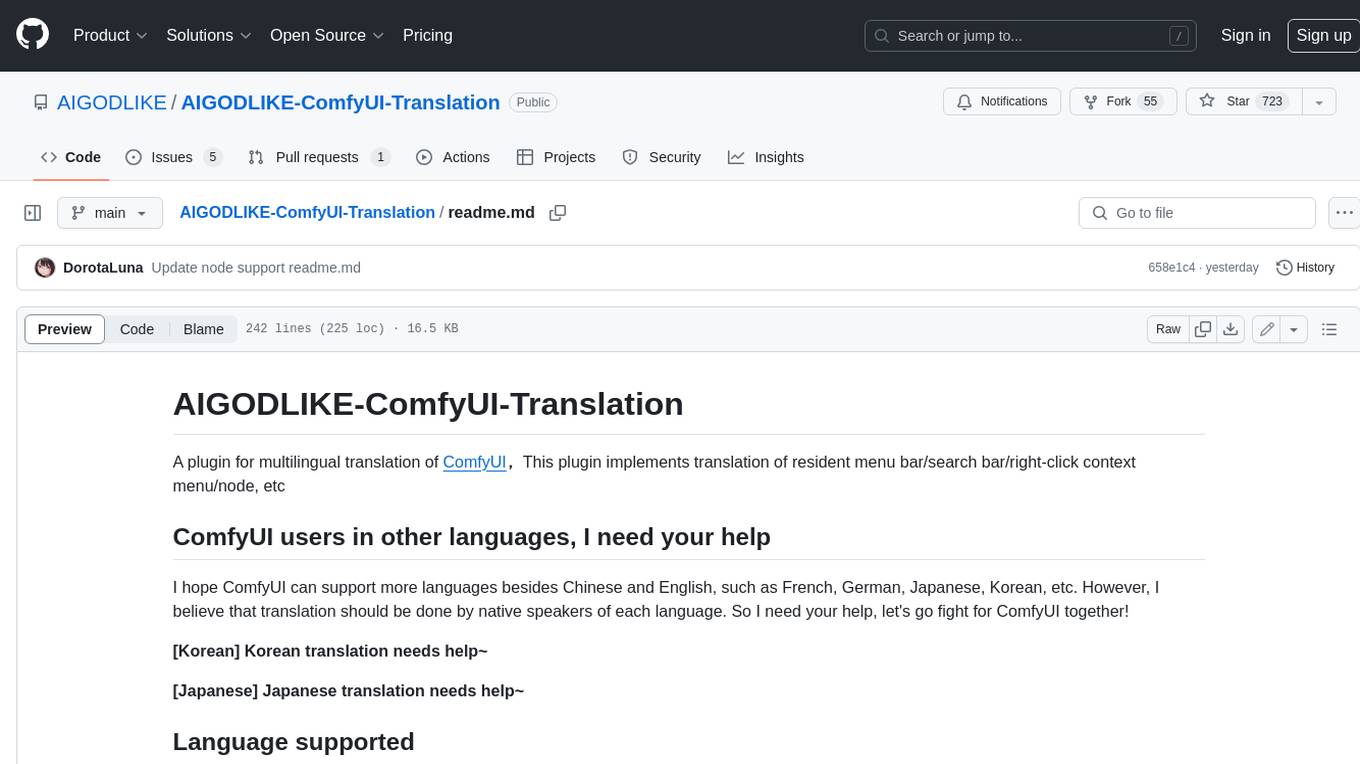
AIGODLIKE-ComfyUI-Translation
A plugin for multilingual translation of ComfyUI, This plugin implements translation of resident menu bar/search bar/right-click context menu/node, etc

aio-pika
Aio-pika is a wrapper around aiormq for asyncio and humans. It provides a completely asynchronous API, object-oriented API, transparent auto-reconnects with complete state recovery, Python 3.7+ compatibility, transparent publisher confirms support, transactions support, and complete type-hints coverage.
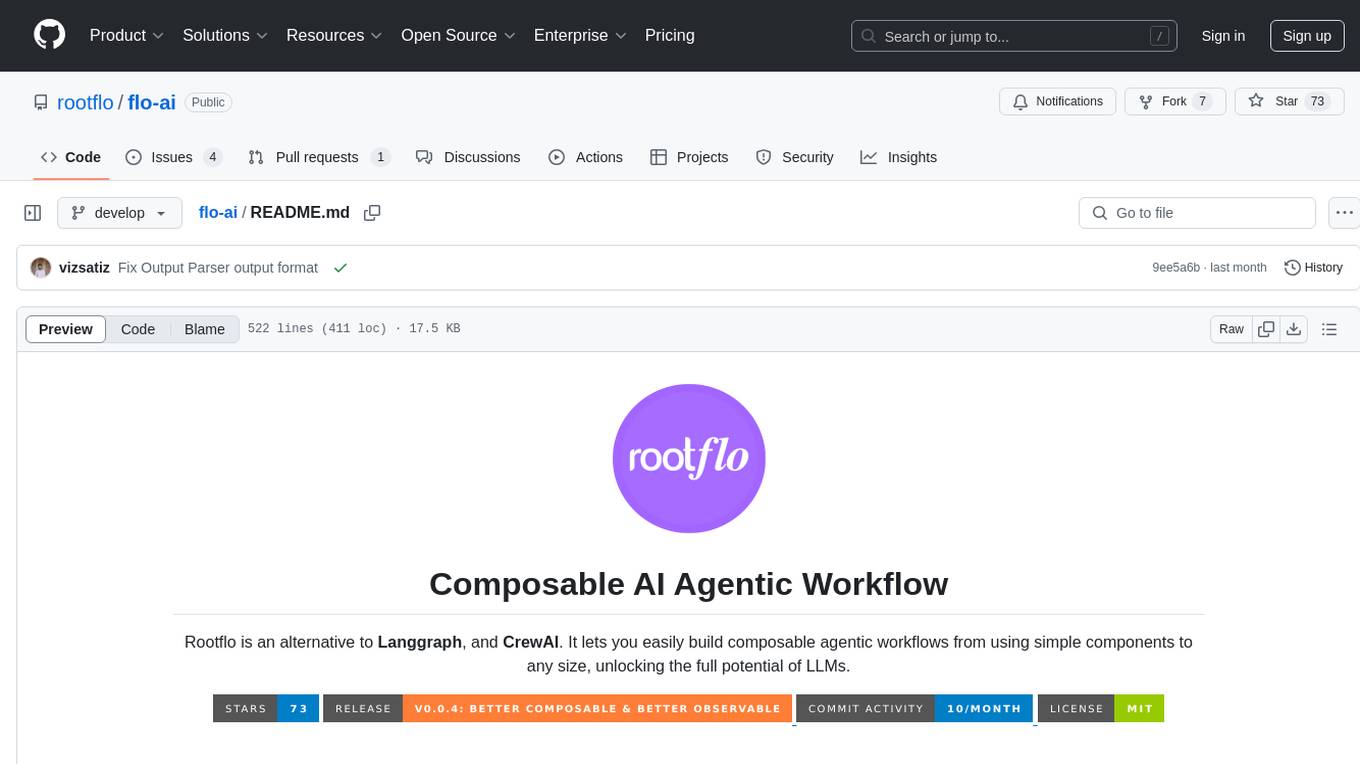
flo-ai
Flo AI is a Python framework that enables users to build production-ready AI agents and teams with minimal code. It allows users to compose complex AI architectures using pre-built components while maintaining the flexibility to create custom components. The framework supports composable, production-ready, YAML-first, and flexible AI systems. Users can easily create AI agents and teams, manage teams of AI agents working together, and utilize built-in support for Retrieval-Augmented Generation (RAG) and compatibility with Langchain tools. Flo AI also provides tools for output parsing and formatting, tool logging, data collection, and JSON output collection. It is MIT Licensed and offers detailed documentation, tutorials, and examples for AI engineers and teams to accelerate development, maintainability, scalability, and testability of AI systems.
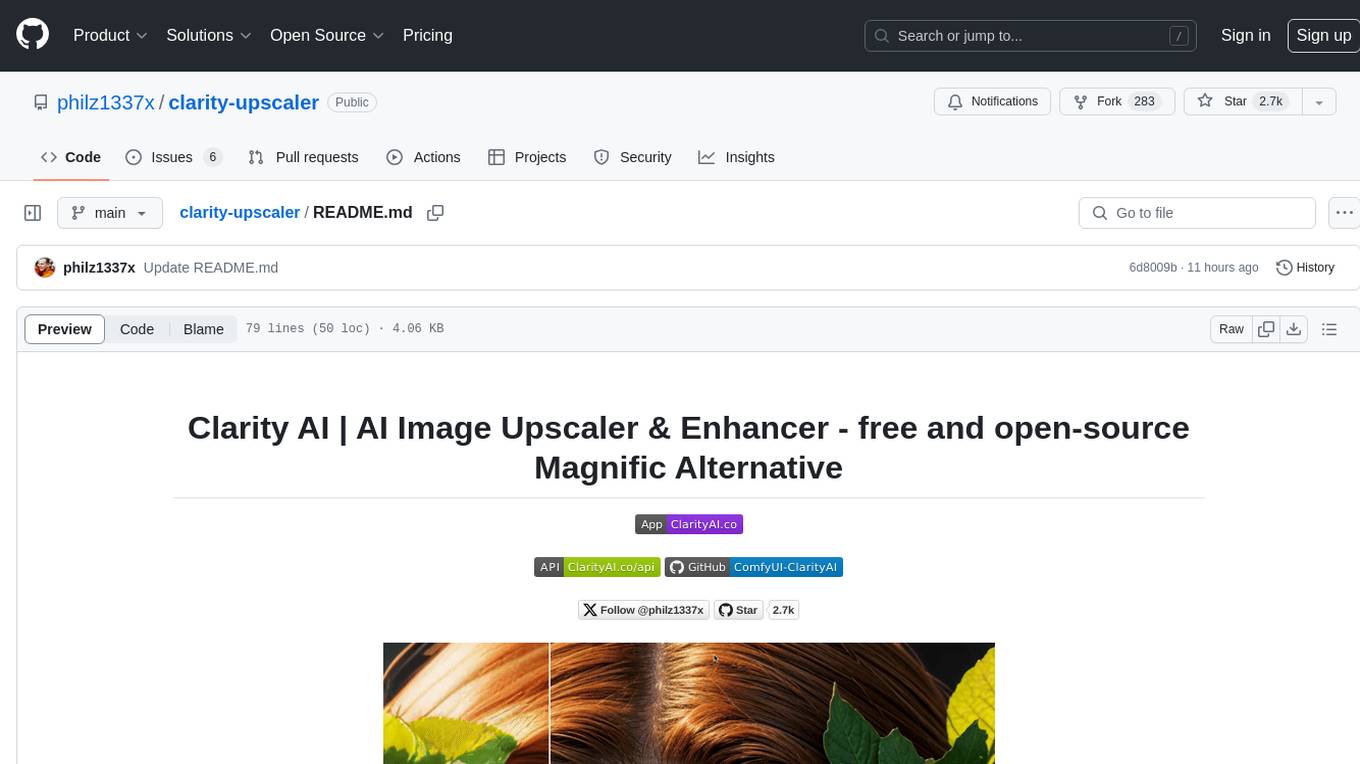
clarity-upscaler
Clarity AI is a free and open-source AI image upscaler and enhancer, providing an alternative to Magnific. It offers various features such as multi-step upscaling, resemblance fixing, speed improvements, support for custom safetensors checkpoints, anime upscaling, LoRa support, pre-downscaling, and fractality. Users can access the tool through the ClarityAI.co app, ComfyUI manager, API, or by deploying and running locally or in the cloud with cog or A1111 webUI. The tool aims to enhance image quality and resolution using advanced AI algorithms and models.
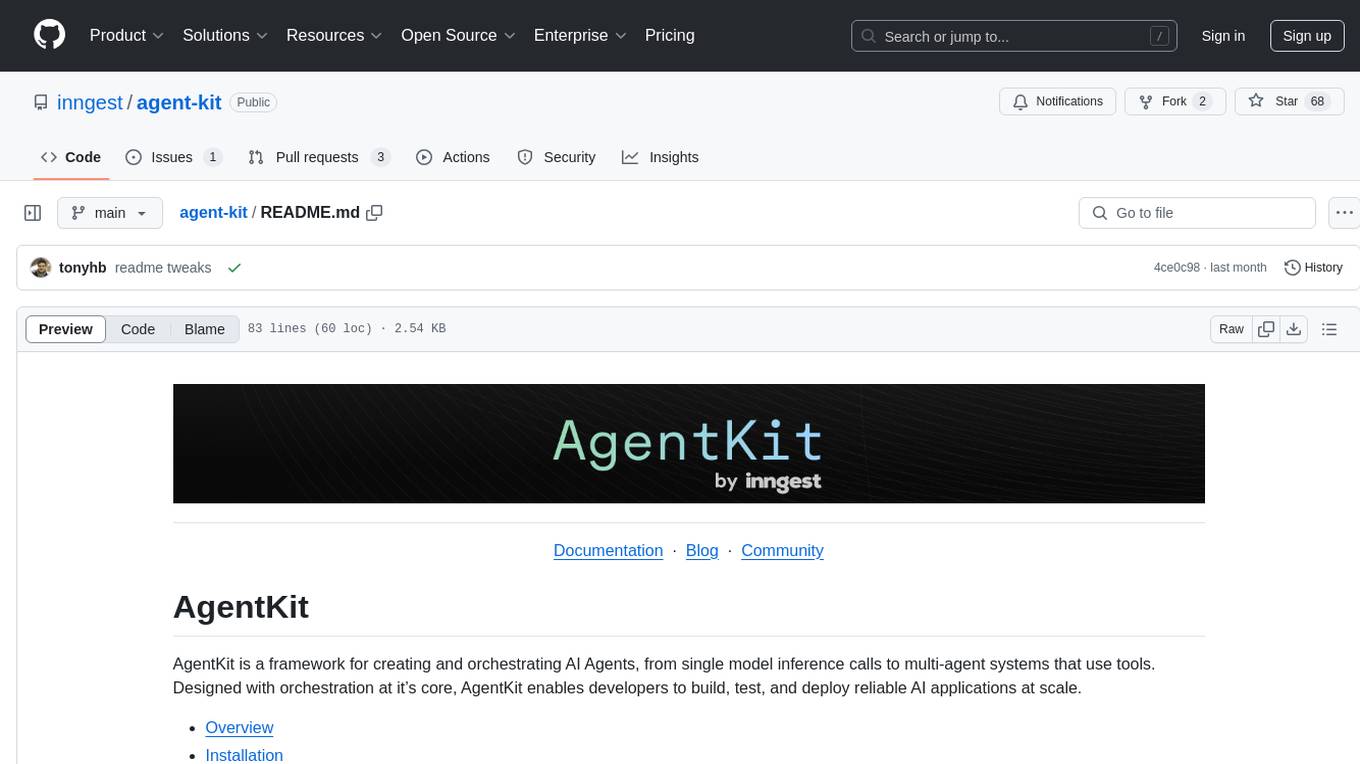
agent-kit
AgentKit is a framework for creating and orchestrating AI Agents, enabling developers to build, test, and deploy reliable AI applications at scale. It allows for creating networked agents with separate tasks and instructions to solve specific tasks, as well as simple agents for tasks like writing content. The framework requires the Inngest TypeScript SDK as a dependency and provides documentation on agents, tools, network, state, and routing. Example projects showcase AgentKit in action, such as the Test Writing Network demo using Workflow Kit, Supabase, and OpenAI.
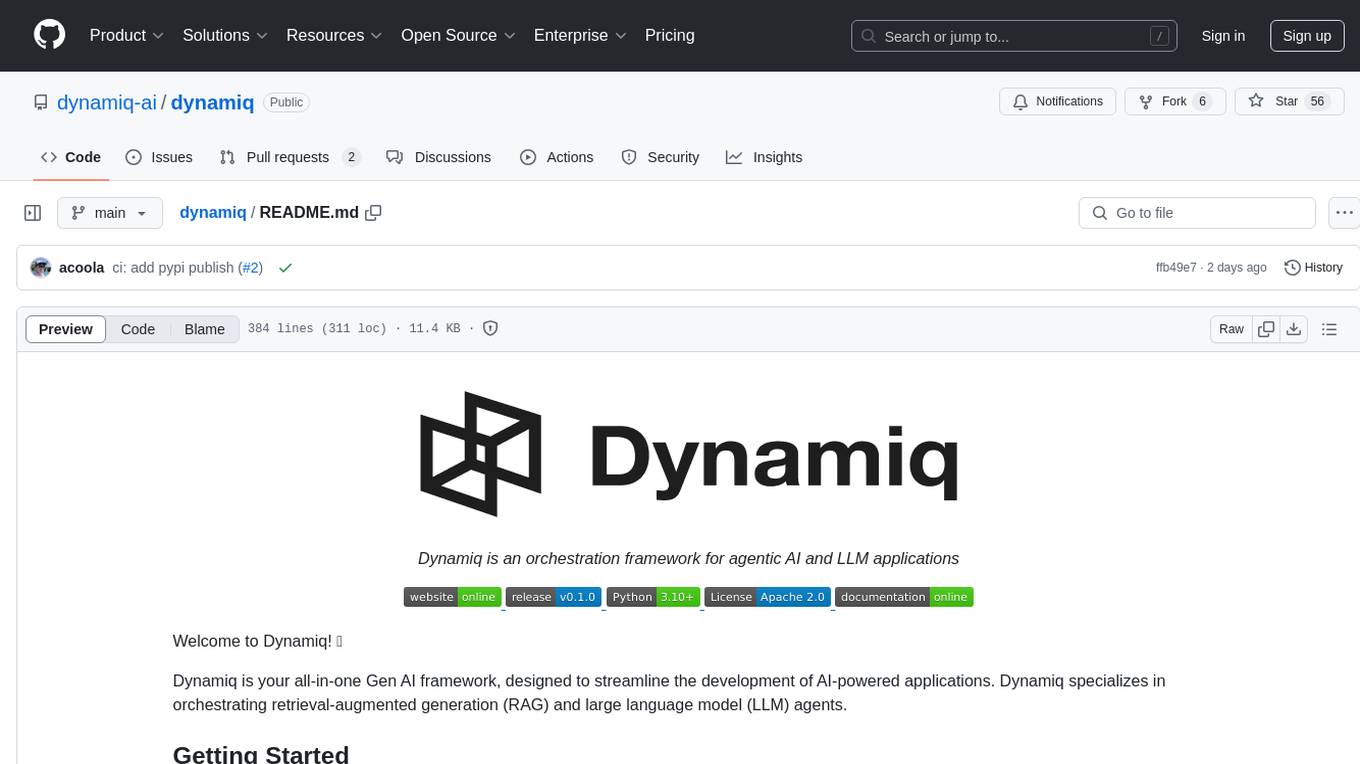
dynamiq
Dynamiq is an orchestration framework designed to streamline the development of AI-powered applications, specializing in orchestrating retrieval-augmented generation (RAG) and large language model (LLM) agents. It provides an all-in-one Gen AI framework for agentic AI and LLM applications, offering tools for multi-agent orchestration, document indexing, and retrieval flows. With Dynamiq, users can easily build and deploy AI solutions for various tasks.
For similar tasks

aiohttp-pydantic
Aiohttp pydantic is an aiohttp view to easily parse and validate requests. You define using function annotations what your methods for handling HTTP verbs expect, and Aiohttp pydantic parses the HTTP request for you, validates the data, and injects the parameters you want. It provides features like query string, request body, URL path, and HTTP headers validation, as well as Open API Specification generation.
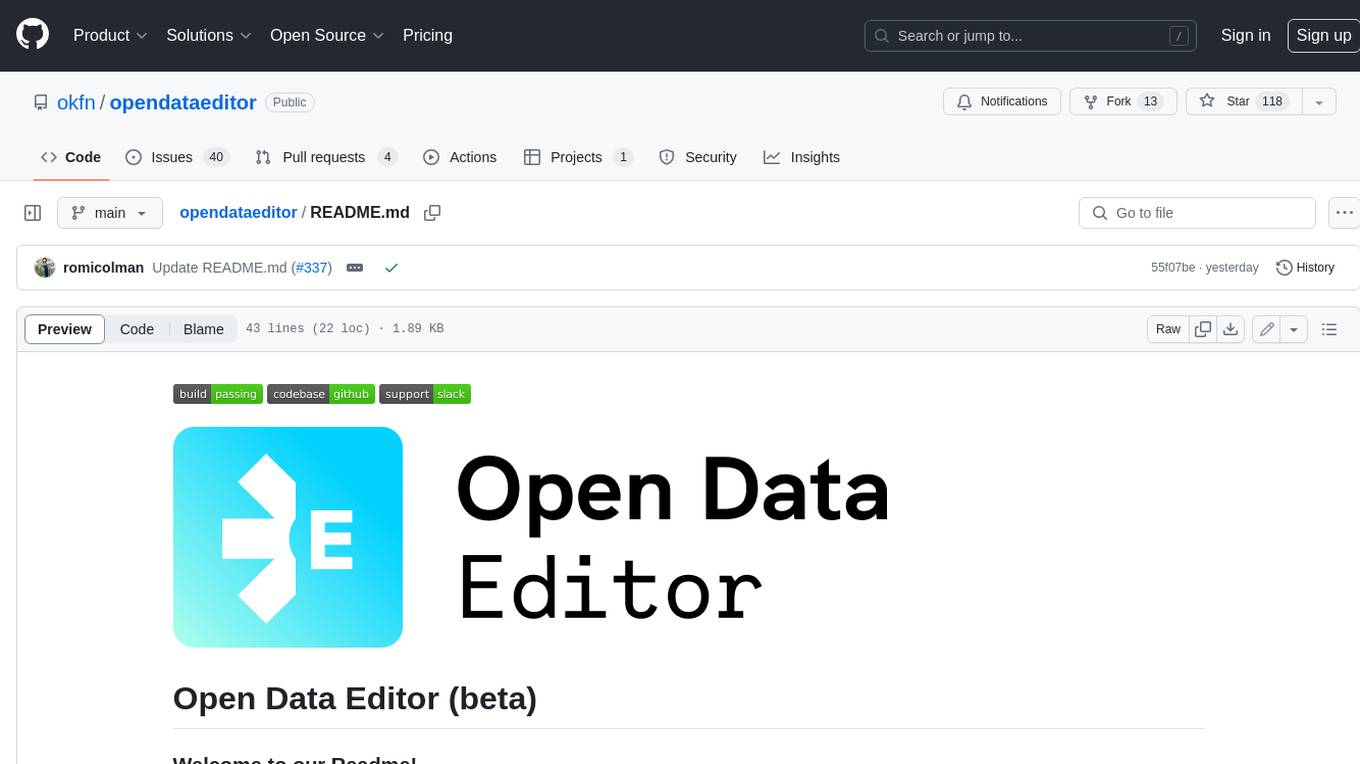
opendataeditor
The Open Data Editor (ODE) is a no-code application to explore, validate and publish data in a simple way. It is an open source project powered by the Frictionless Framework. The ODE is currently available for download and testing in beta.
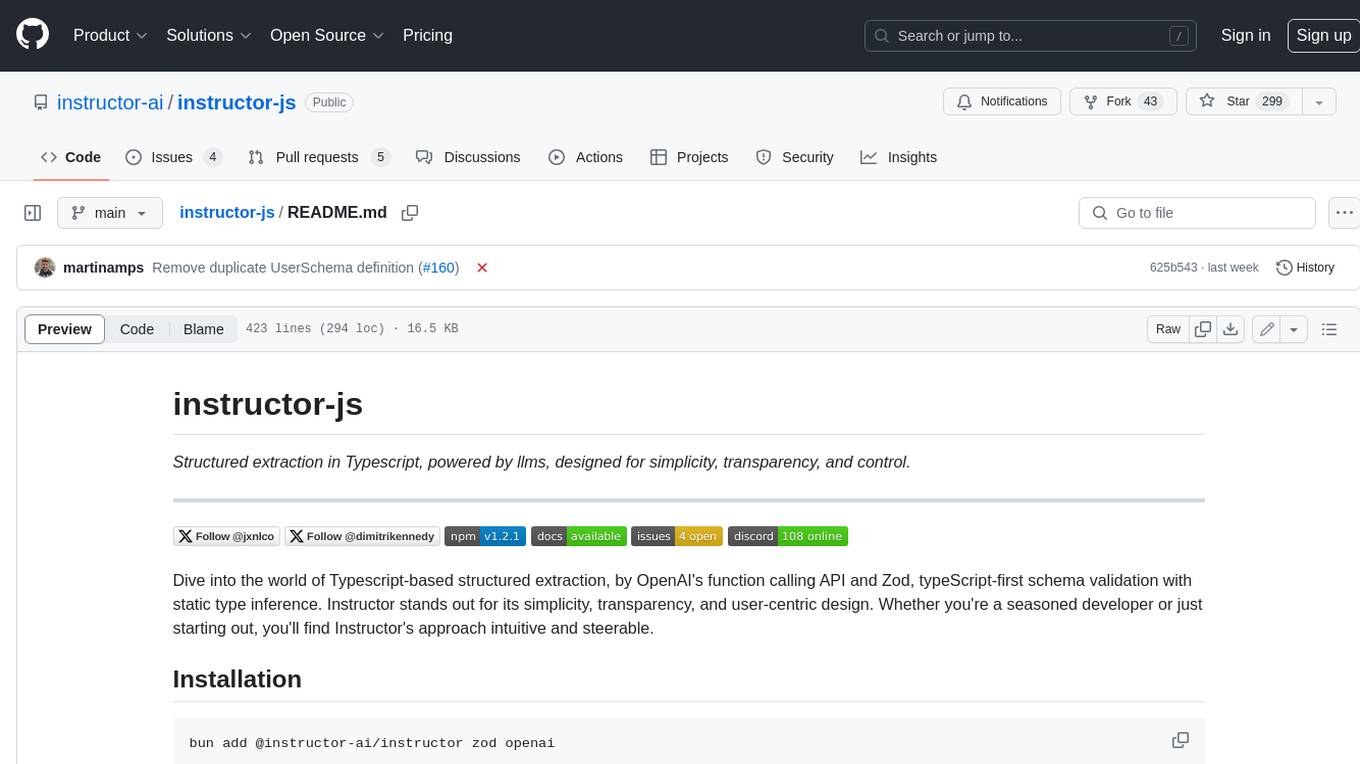
instructor-js
Instructor is a Typescript library for structured extraction in Typescript, powered by llms, designed for simplicity, transparency, and control. It stands out for its simplicity, transparency, and user-centric design. Whether you're a seasoned developer or just starting out, you'll find Instructor's approach intuitive and steerable.
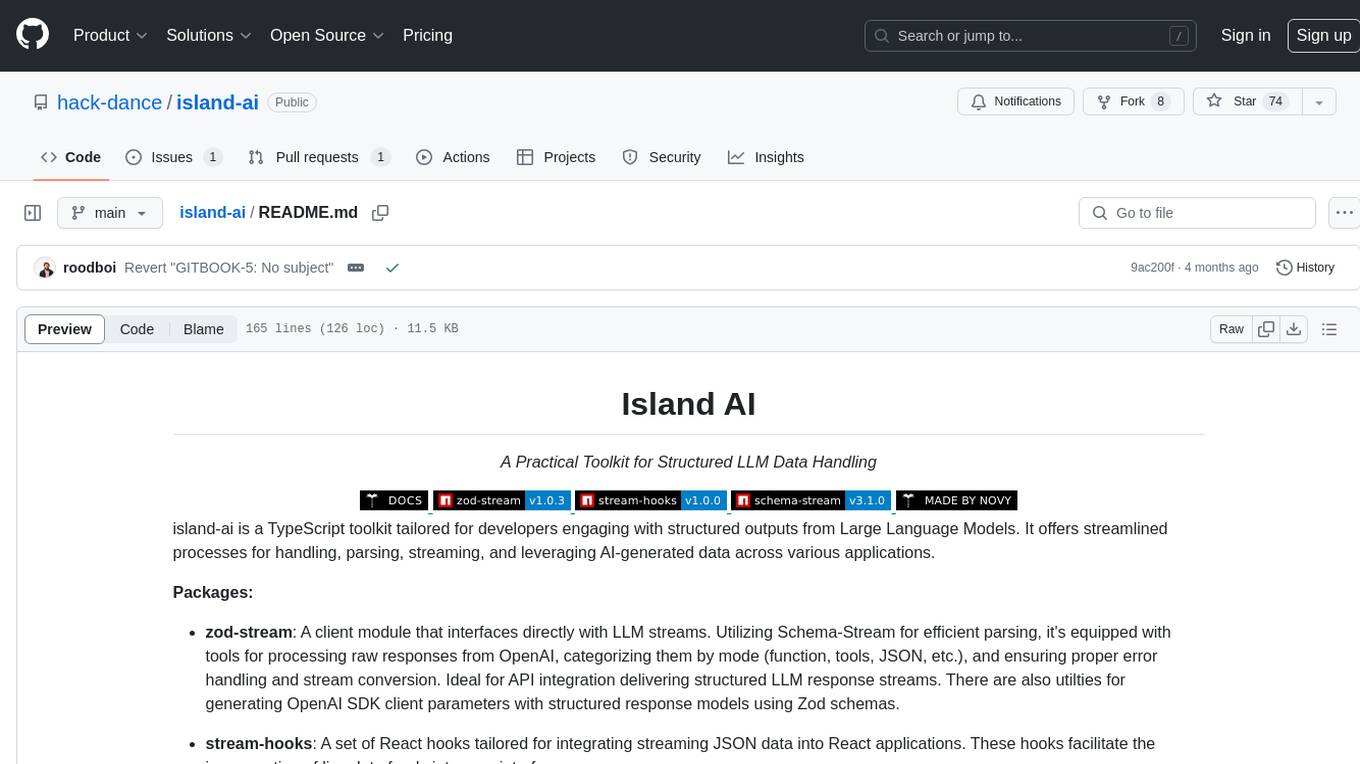
island-ai
island-ai is a TypeScript toolkit tailored for developers engaging with structured outputs from Large Language Models. It offers streamlined processes for handling, parsing, streaming, and leveraging AI-generated data across various applications. The toolkit includes packages like zod-stream for interfacing with LLM streams, stream-hooks for integrating streaming JSON data into React applications, and schema-stream for JSON streaming parsing based on Zod schemas. Additionally, related packages like @instructor-ai/instructor-js focus on data validation and retry mechanisms, enhancing the reliability of data processing workflows.
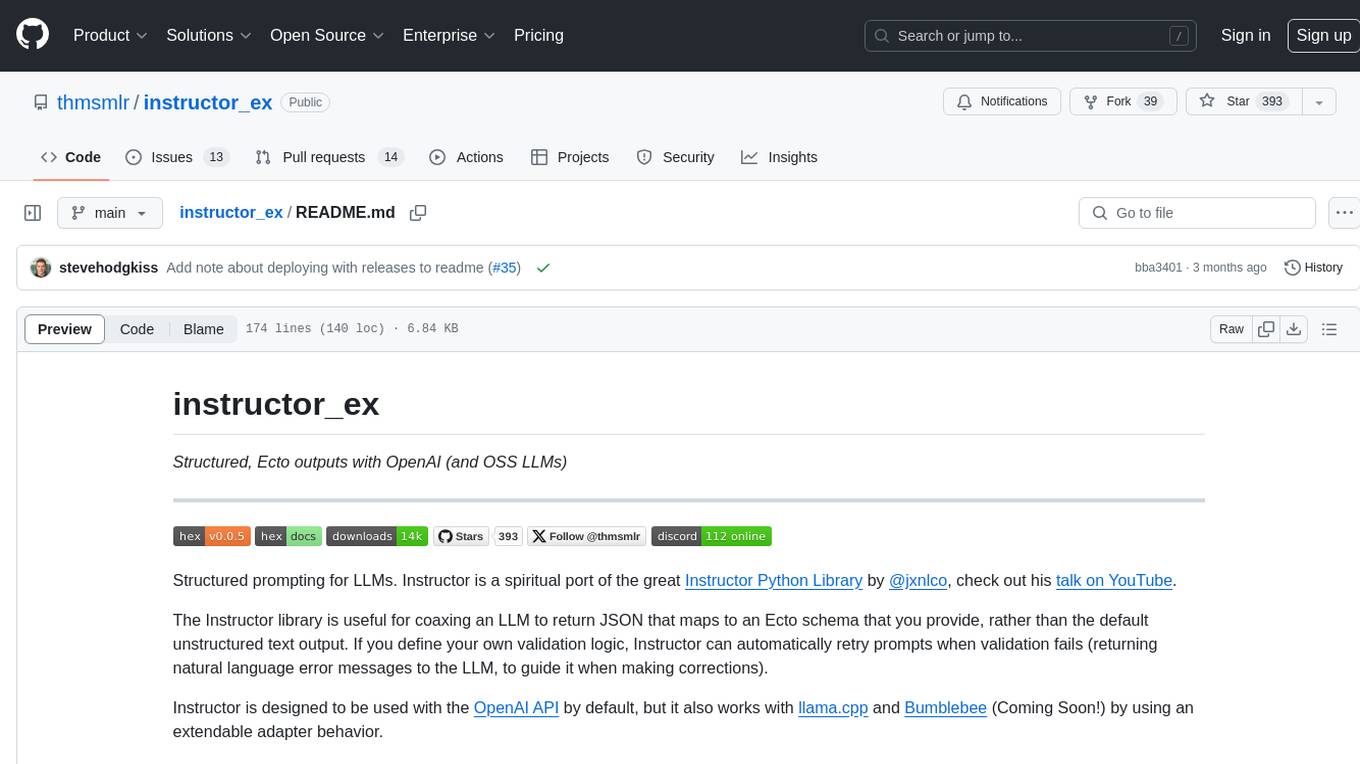
instructor_ex
Instructor is a tool designed to structure outputs from OpenAI and other OSS LLMs by coaxing them to return JSON that maps to a provided Ecto schema. It allows for defining validation logic to guide LLMs in making corrections, and supports automatic retries. Instructor is primarily used with the OpenAI API but can be extended to work with other platforms. The tool simplifies usage by creating an ecto schema, defining a validation function, and making calls to chat_completion with instructions for the LLM. It also offers features like max_retries to fix validation errors iteratively.
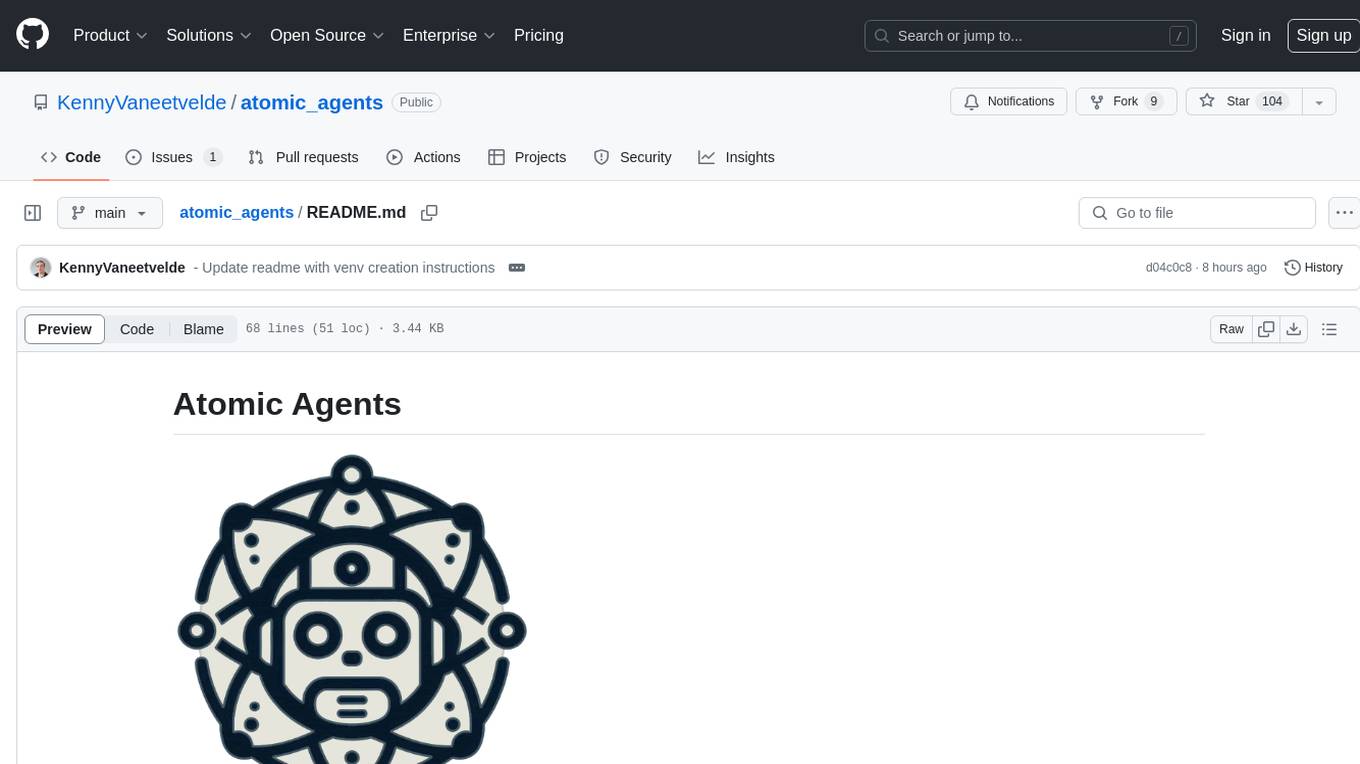
atomic_agents
Atomic Agents is a modular and extensible framework designed for creating powerful applications. It follows the principles of Atomic Design, emphasizing small and single-purpose components. Leveraging Pydantic for data validation and serialization, the framework offers a set of tools and agents that can be combined to build AI applications. It depends on the Instructor package and supports various APIs like OpenAI, Cohere, Anthropic, and Gemini. Atomic Agents is suitable for developers looking to create AI agents with a focus on modularity and flexibility.
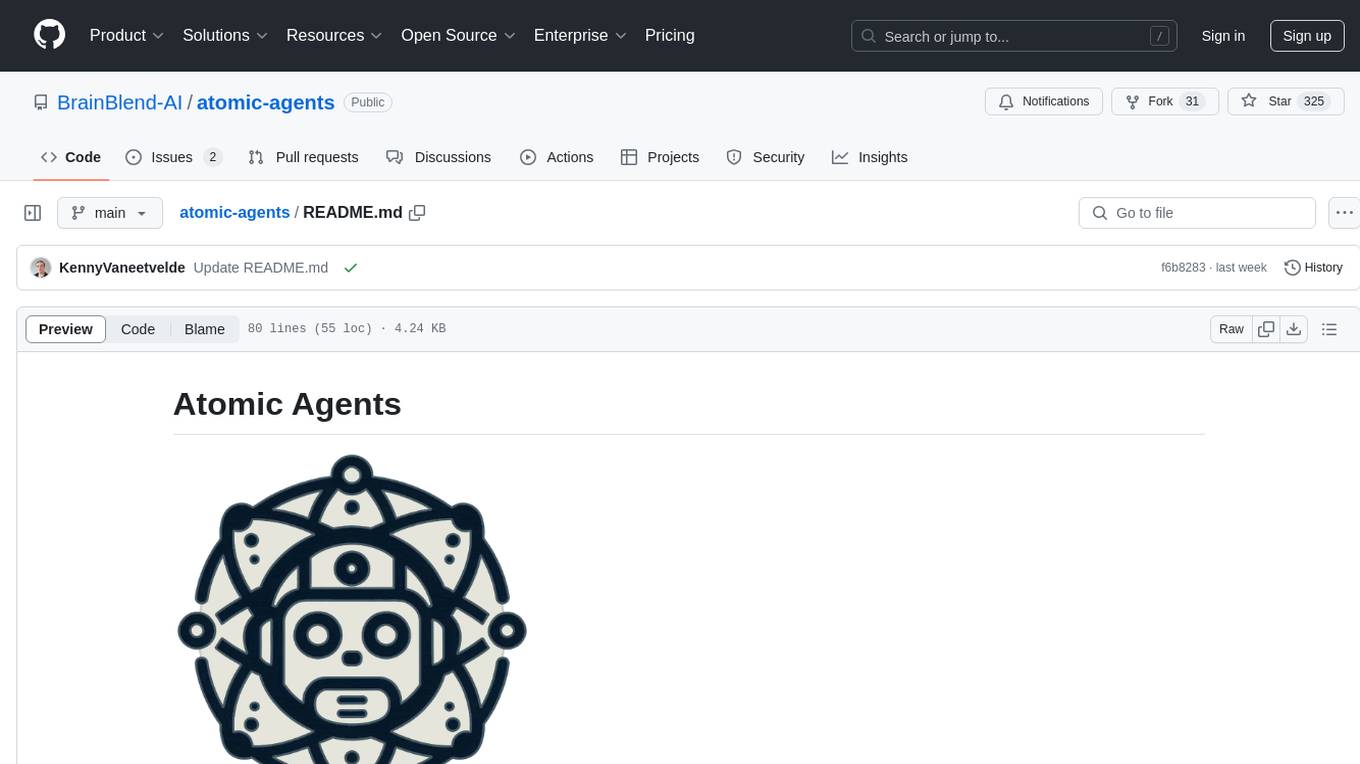
atomic-agents
The Atomic Agents framework is a modular and extensible tool designed for creating powerful applications. It leverages Pydantic for data validation and serialization. The framework follows the principles of Atomic Design, providing small and single-purpose components that can be combined. It integrates with Instructor for AI agent architecture and supports various APIs like Cohere, Anthropic, and Gemini. The tool includes documentation, examples, and testing features to ensure smooth development and usage.
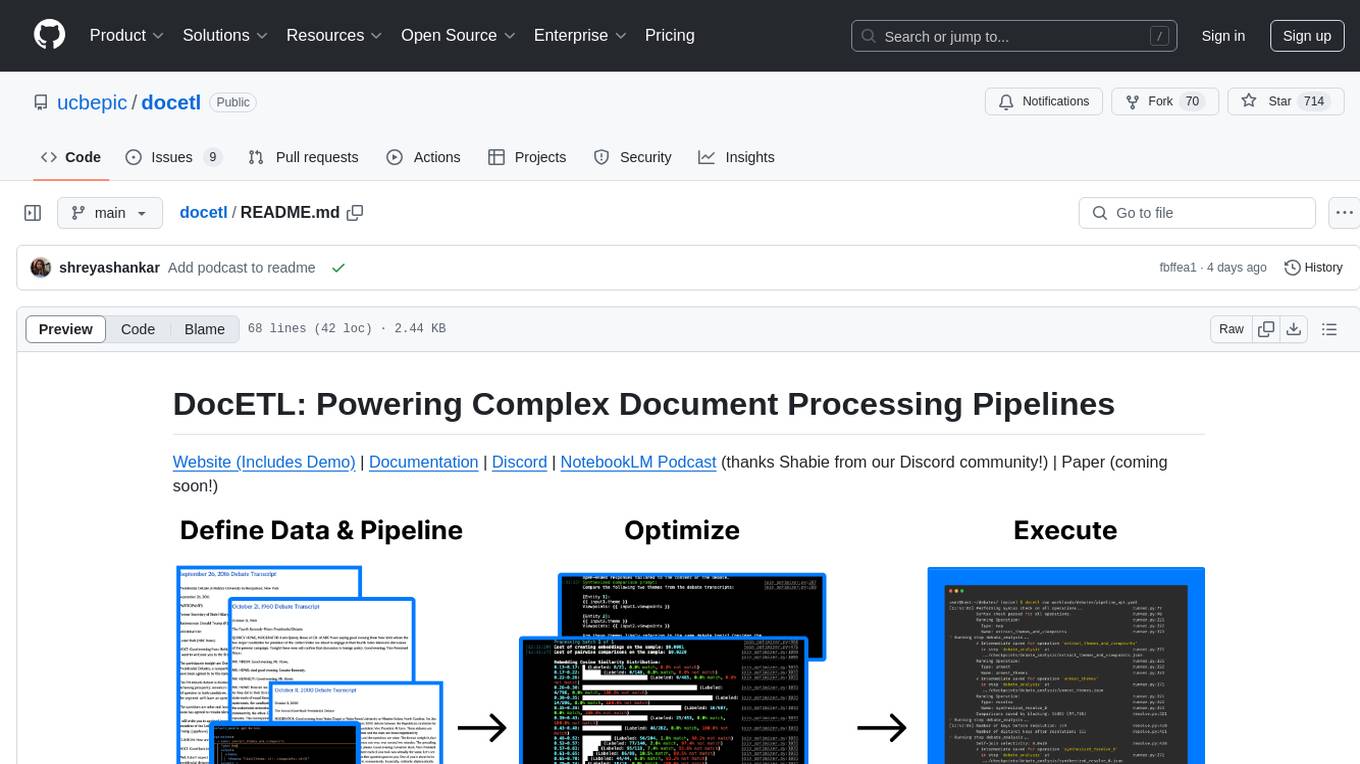
docetl
DocETL is a tool for creating and executing data processing pipelines, especially suited for complex document processing tasks. It offers a low-code, declarative YAML interface to define LLM-powered operations on complex data. Ideal for maximizing correctness and output quality for semantic processing on a collection of data, representing complex tasks via map-reduce, maximizing LLM accuracy, handling long documents, and automating task retries based on validation criteria.
For similar jobs
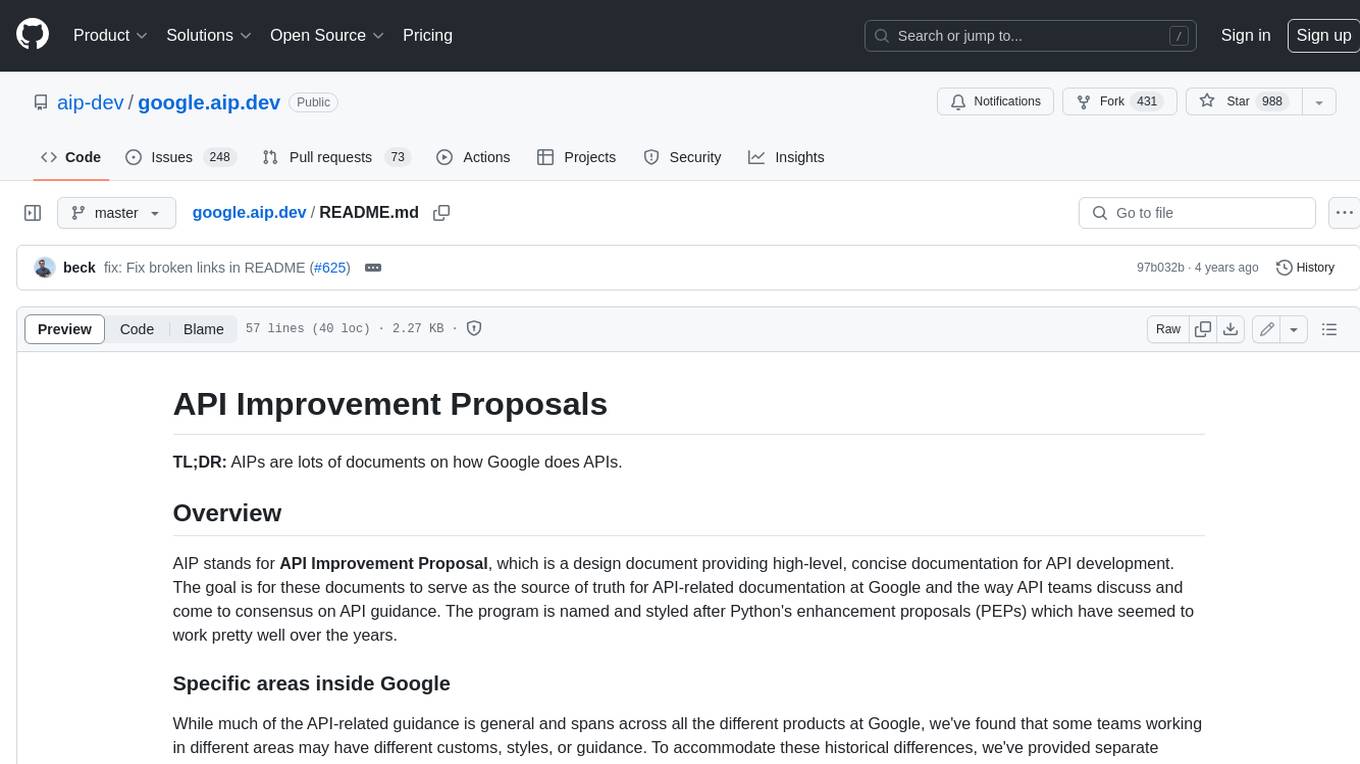
google.aip.dev
API Improvement Proposals (AIPs) are design documents that provide high-level, concise documentation for API development at Google. The goal of AIPs is to serve as the source of truth for API-related documentation and to facilitate discussion and consensus among API teams. AIPs are similar to Python's enhancement proposals (PEPs) and are organized into different areas within Google to accommodate historical differences in customs, styles, and guidance.
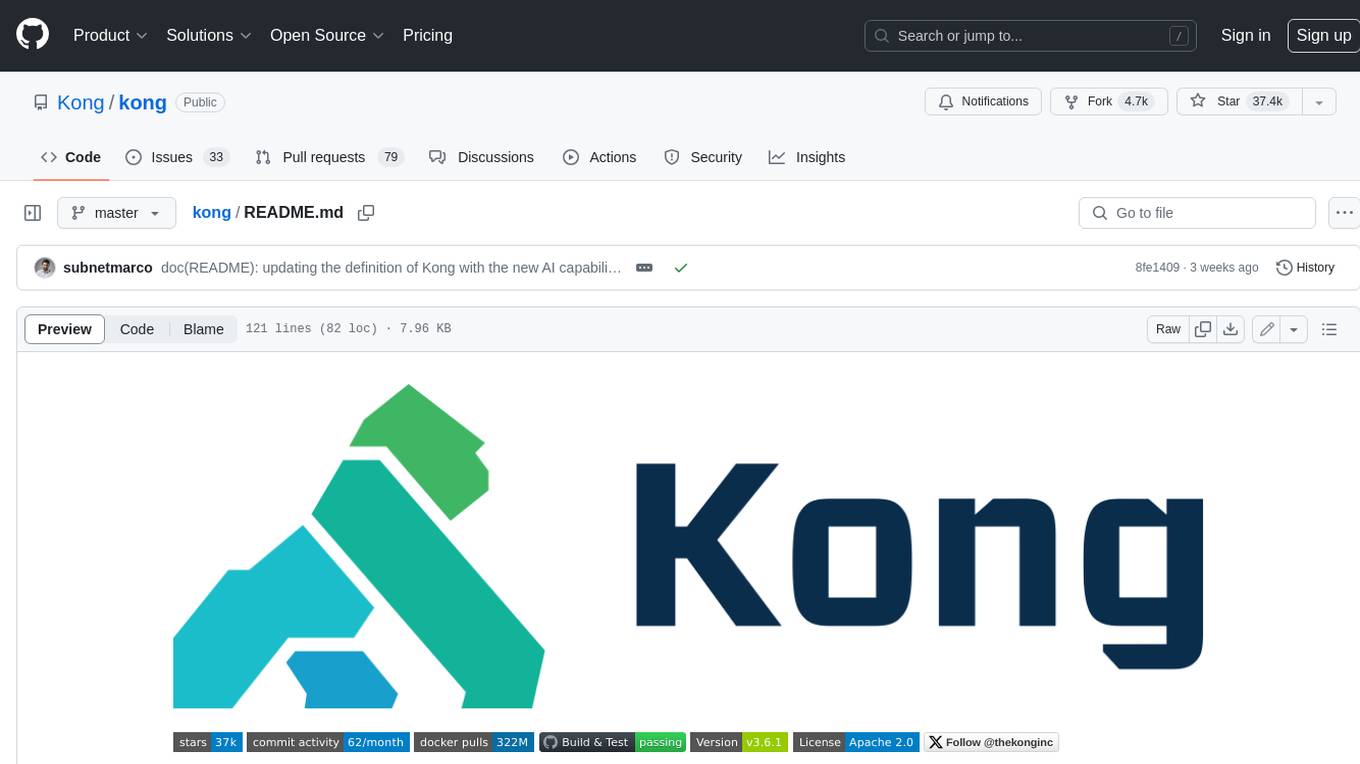
kong
Kong, or Kong API Gateway, is a cloud-native, platform-agnostic, scalable API Gateway distinguished for its high performance and extensibility via plugins. It also provides advanced AI capabilities with multi-LLM support. By providing functionality for proxying, routing, load balancing, health checking, authentication (and more), Kong serves as the central layer for orchestrating microservices or conventional API traffic with ease. Kong runs natively on Kubernetes thanks to its official Kubernetes Ingress Controller.
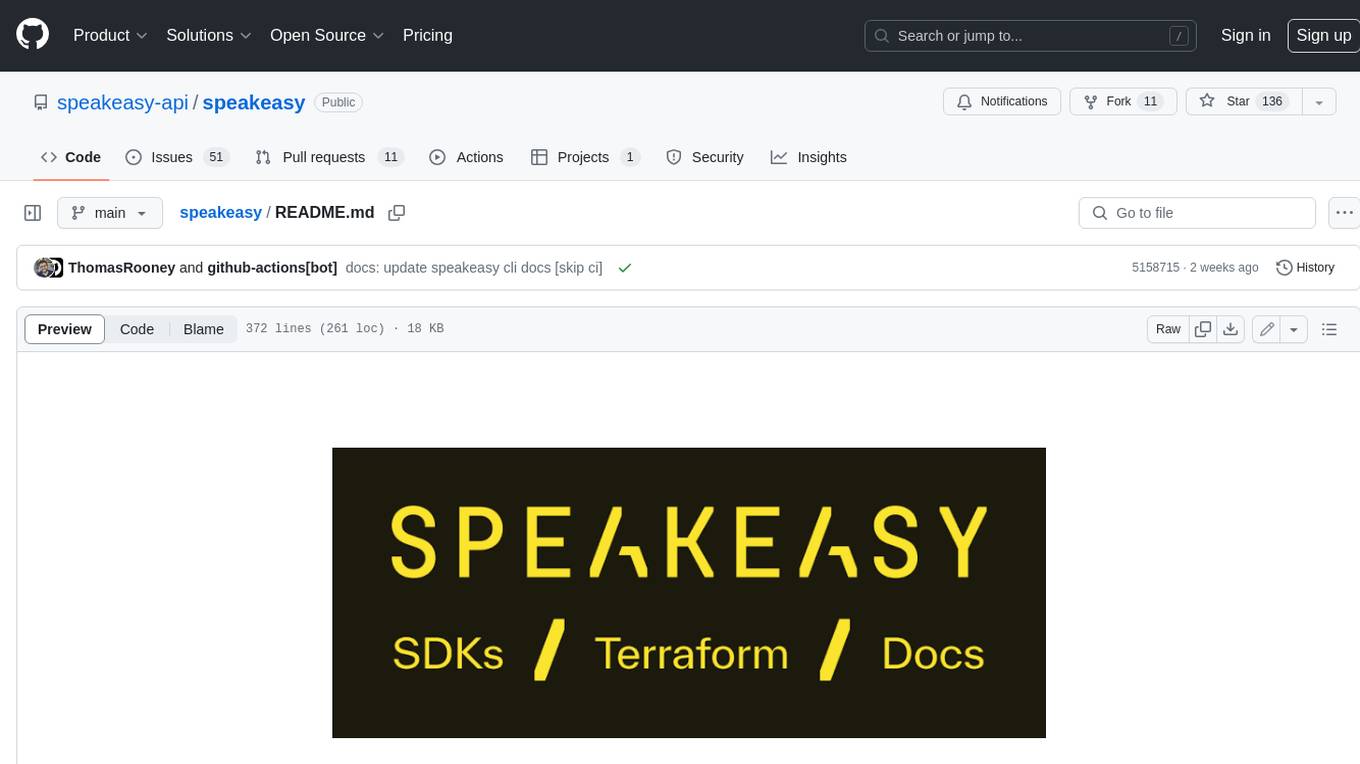
speakeasy
Speakeasy is a tool that helps developers create production-quality SDKs, Terraform providers, documentation, and more from OpenAPI specifications. It supports a wide range of languages, including Go, Python, TypeScript, Java, and C#, and provides features such as automatic maintenance, type safety, and fault tolerance. Speakeasy also integrates with popular package managers like npm, PyPI, Maven, and Terraform Registry for easy distribution.
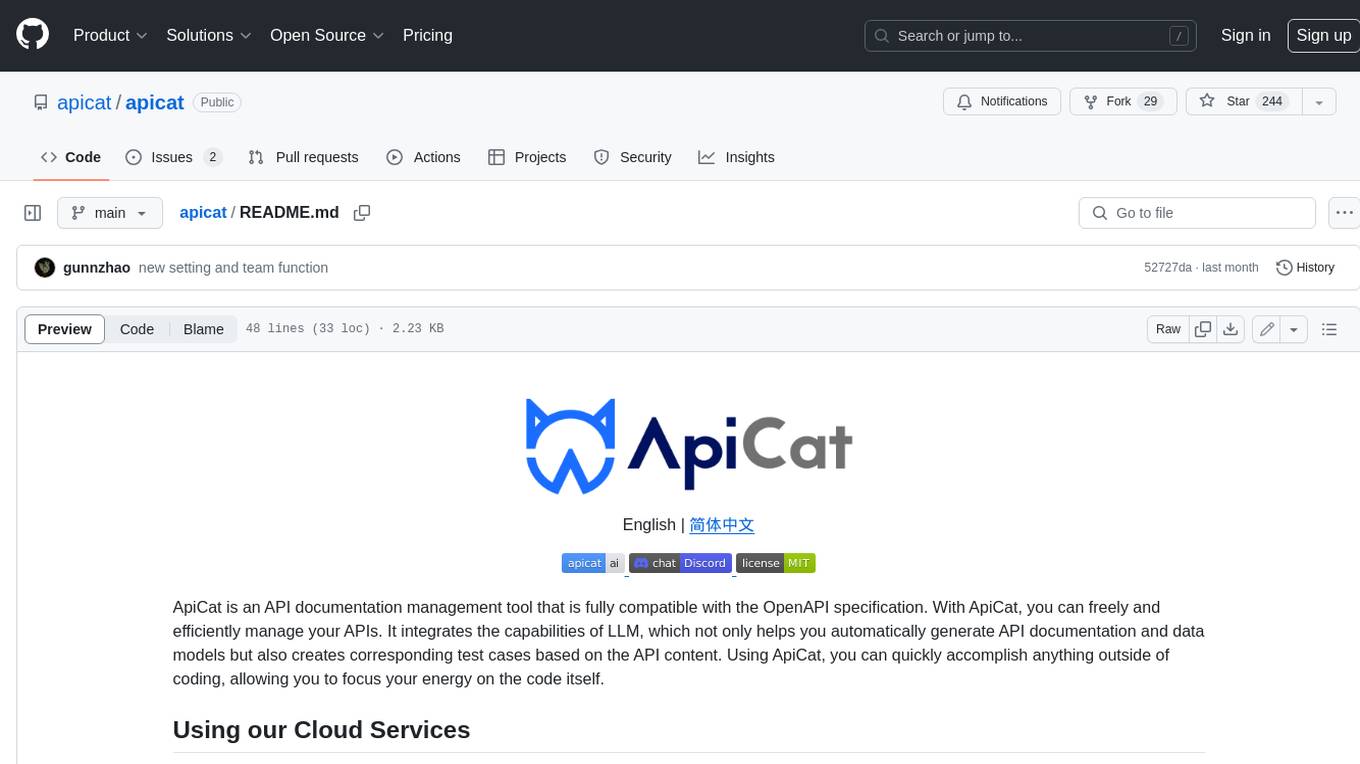
apicat
ApiCat is an API documentation management tool that is fully compatible with the OpenAPI specification. With ApiCat, you can freely and efficiently manage your APIs. It integrates the capabilities of LLM, which not only helps you automatically generate API documentation and data models but also creates corresponding test cases based on the API content. Using ApiCat, you can quickly accomplish anything outside of coding, allowing you to focus your energy on the code itself.

aiohttp-pydantic
Aiohttp pydantic is an aiohttp view to easily parse and validate requests. You define using function annotations what your methods for handling HTTP verbs expect, and Aiohttp pydantic parses the HTTP request for you, validates the data, and injects the parameters you want. It provides features like query string, request body, URL path, and HTTP headers validation, as well as Open API Specification generation.
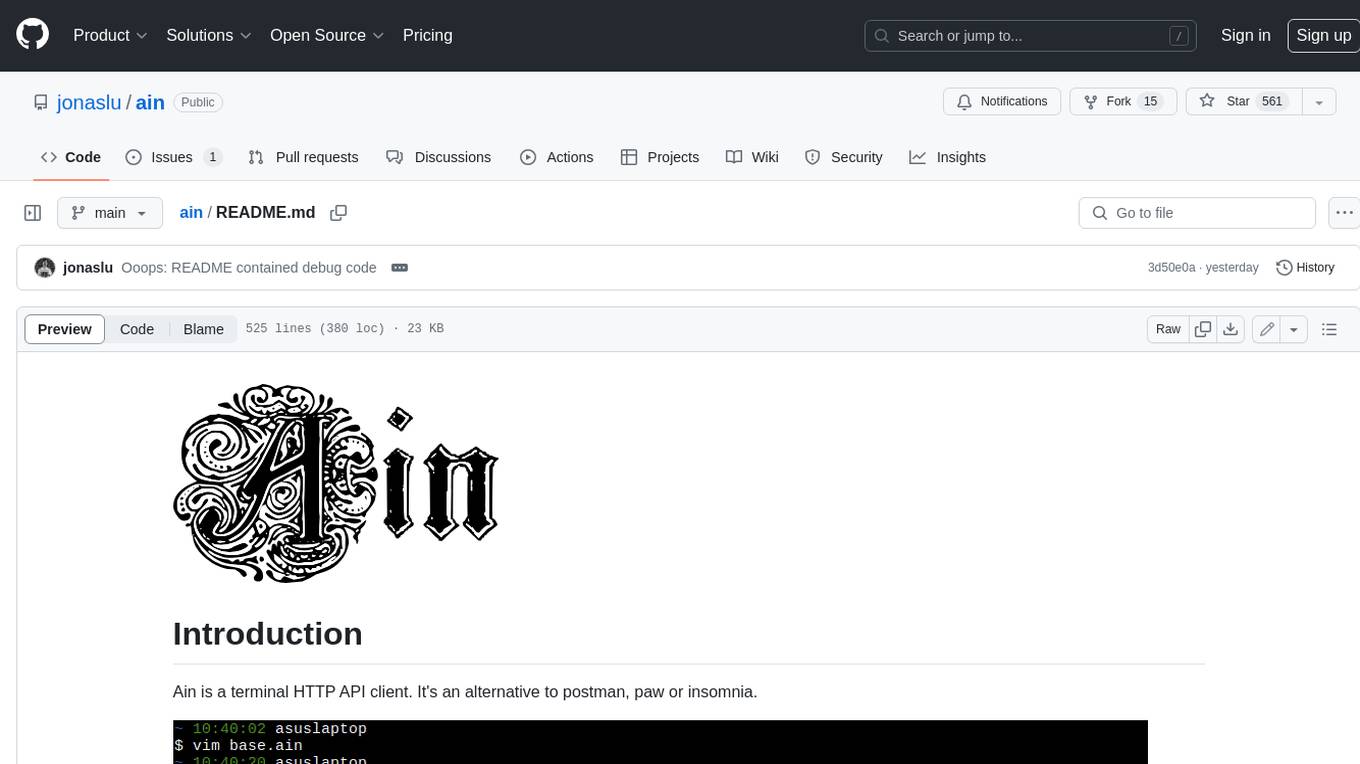
ain
Ain is a terminal HTTP API client designed for scripting input and processing output via pipes. It allows flexible organization of APIs using files and folders, supports shell-scripts and executables for common tasks, handles url-encoding, and enables sharing the resulting curl, wget, or httpie command-line. Users can put things that change in environment variables or .env-files, and pipe the API output for further processing. Ain targets users who work with many APIs using a simple file format and uses curl, wget, or httpie to make the actual calls.
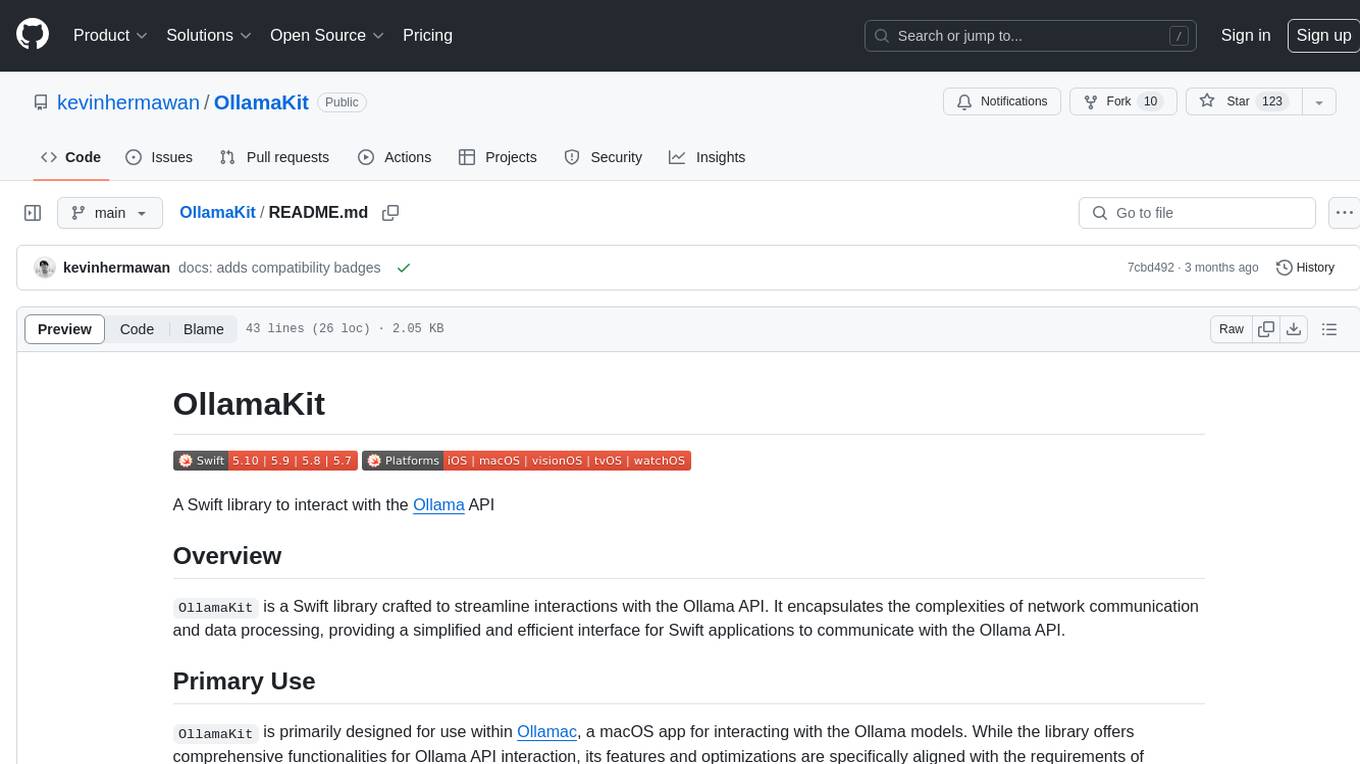
OllamaKit
OllamaKit is a Swift library designed to simplify interactions with the Ollama API. It handles network communication and data processing, offering an efficient interface for Swift applications to communicate with the Ollama API. The library is optimized for use within Ollamac, a macOS app for interacting with Ollama models.
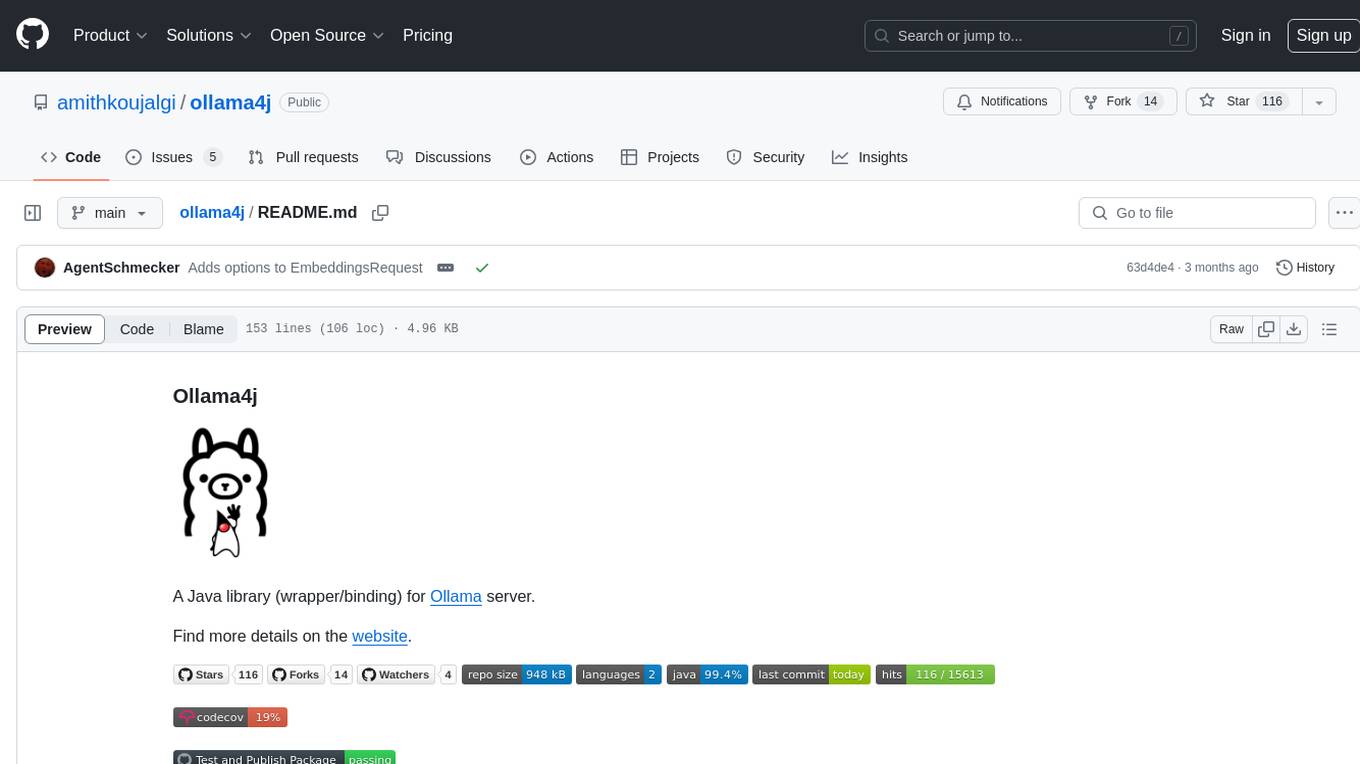
ollama4j
Ollama4j is a Java library that serves as a wrapper or binding for the Ollama server. It facilitates communication with the Ollama server and provides models for deployment. The tool requires Java 11 or higher and can be installed locally or via Docker. Users can integrate Ollama4j into Maven projects by adding the specified dependency. The tool offers API specifications and supports various development tasks such as building, running unit tests, and integration tests. Releases are automated through GitHub Actions CI workflow. Areas of improvement include adhering to Java naming conventions, updating deprecated code, implementing logging, using lombok, and enhancing request body creation. Contributions to the project are encouraged, whether reporting bugs, suggesting enhancements, or contributing code.
